Crawford’s Sea Grill, its tower spelling SEA FOOD in large neon letters, was at water’s edge on Elliott Bay. Author’s collection.
In the Neighborhoods
Former mayor Greg Nickels once described Seattle as a “city of neighborhoods”—127 of them according to the city’s website. How did they come to be? Some of them were once independent towns. Others grew around transportation corridors—in early days, at stops along the interurban trolleys north and south out of Seattle; later, as the automobile became part of the scene, along highways or at important road junctions. The Green Lake neighborhood grew near the lake of the same name. The University District, as its name suggests, grew up near the University of Washington. Others? Who knows why? They each have their own story to tell.
Seattle’s neighborhoods were tied together by a web of arterial streets. Many neighborhoods had (and still have) their own business districts, and it was natural for restaurants to appear both in the local downtowns and along the main routes between them. Industrial areas also attracted eateries—workers in factories and around the harbor needed someplace to do lunch. Overall, the quantity of restaurants in Seattle’s outliers exceeded the number available in the central business district.
Seattle’s Original Neighborhood
In the 1880s, Seattle was a fairly compact city on the shore of Elliott Bay, clustered around the site of Henry Yesler’s mill and hemmed in on the east by remnants of dense forest. About a mile to the north, another community—Belltown—had arisen with its own business district, mill, wharves and residences. What stood between Seattle and Belltown was Denny Hill, several hundred feet in height and, until it was washed away by the Denny Regrade project, a barrier to easy travel between the two places.
It’s known that eateries and at least one hotel were established by the time of the great fire of 1889. The Dakota Restaurant was located at 2417 Front Street, the New Orleans was located at the corner of Front and Battery Streets and Mary Yates and Claude Brown also ran restaurants in the neighborhood. Belltown escaped the flames, and the day after the fire, Bell’s Hotel (also called the Bellevue House) was said to be the only restaurant left in Seattle. Richard Dodge, proprietor of the Bellevue Dining Room, went to great lengths to take care of the hungry men and women who plodded north from the burn zone in search of a meal.
By the turn of the century, there were at least four restaurants in Belltown, along with a saloon and two confectioneries. The district experienced little growth for the next few decades, even after Denny Hill was removed. In 1940, Herman Doder was running Herman’s Cafe at 2309 First Avenue, the Bell Town Cafe was at 2207 First and Christian Steen had another restaurant up the block at 2219.
A new and different Belltown Café appeared in 1979 at 2313 First Avenue, just as the area was beginning to revive. The café’s menu offered chicken breasts stuffed with prosciutto and mushrooms, a pork-sausage-and-rice mixture wrapped in cabbage leaves and creamy soups and fish mousses, along with several vegetarian entrées. Co-owners Ben Marks, Phil Messina and Pat Tyler highlighted family recipes; everything—bread, sauces, dressings, desserts—was made on-site. Today a Brazilian-themed restaurant, the Grill From Ipanema, occupies the site. Belltown, having been rediscovered and rebuilt, is considered one of the most desirable (and expensive) places to live in Seattle.
Even longtime Seattleites are surprised to learn that the city has 200 miles of waterfront—about 54 miles of saltwater shoreline and another 147 miles along Lake Washington, Lake Union and the Ship Canal. With views westward toward the Olympic Mountains and east to the Cascades, it’s no wonder that many restaurants have chosen the waterfront to call home.
The early settlers probably didn’t take scenery into consideration when the first restaurants appeared downtown. Any restaurant built on Front or Commercial Streets was on the waterfront—at the time, Elliott Bay lapped up almost to the streets. It wasn’t until the 1930s that restaurateurs began locating their eateries along the water specifically to take advantage of the views.
Among the first was Crawford’s Sea Grill, on Elliott Avenue about a mile northwest of the downtown core. In July 1940, the Seattle Daily Times announced the opening of the Sea Grill at 309 Elliott Avenue. Veteran restaurateur C.C. Crawford had been planning it for ten years; designed to take advantage of the sweeping view of Elliott Bay, it was built and completely equipped for $31,000. The glass-enclosed main dining room seated 188 patrons and provided an unobstructed view of Puget Sound and the Olympics. Crawford’s motto was “a showplace on the shore of Puget Sound”; his goal was to specialize in “serving the widest variety of sea foods, all prepared on a specially designed broiler, with olive oil used exclusively in the preparation.” The menu featured all kinds of seafood: scallops, lobster, snapper, salmon, smelt, sole, tuna, clams, shrimp, oysters, abalone and halibut, plus juicy broiled steaks, chicken and turkey roasted to perfection.
Only five months after opening, the restaurant had become so popular that an addition was constructed to increase the seating space. Unfortunately, C.C. Crawford didn’t have much time to savor his restaurant’s success, as he passed away in 1942. J.E. Meaker took over for a few years before selling out to Nick Zanides and moving to Tacoma, where he opened a Crawford’s. Zenides remodeled the Sea Grill in 1948, creating a congenial, modern, marine ambiance with an interior décor of ship ornaments, seashells, marine life, fishnet curtains and other decorations stressing marine atmosphere. A cocktail lounge, the Coral Room, was added, along with a garden where it was claimed five hundred varieties of roses were grown. Ivar Haglund bought the property in 1965 and moved his Captain’s Table there from its original Fifth Avenue location. The Captain’s Table closed in 1991, and today a medical facility occupies the property.
Crawford’s Sea Grill, its tower spelling SEA FOOD in large neon letters, was at water’s edge on Elliott Bay. Author’s collection.
The Ocean House opened in 1941 just one hundred yards farther along at 375 Elliott Avenue. Initially owned by Evelyn Howie, within a year, it was taken over by Jennie Mangini, with Wener Gloor as seafood chef. Not surprisingly, the Ocean House specialized in seafood but also offered broiled steaks and roast chicken. Lunch was served daily. In 1973, the Ocean House closed; all the equipment was auctioned off. A year later, a new Ocean House appeared at 920 Aurora Avenue, quarters previously occupied by Les Teagle’s; it closed in 1979. Today, there’s an office complex on the site of the original Ocean House—the later Aurora Avenue site is an office tower.
Skipper’s Seafood Restaurant was at 208 Elliott, where the Homewood Suites hotel is today. The vaguely ship-shaped restaurant was built by Ernest Hilsenberg and Curt Kremer in 1942. The nautical theme included a lighthouse, pilot house and porthole-style windows; inside, tables were decorated with charts, and the walls were hung with pictures of ships. A 1960 visitor commented:
Skipper’s has been one of the best restaurants to get the small oysters, Olympias, Quilcenes and Cove, cooked so gently to make them tender. The other types of seafood are the best ever and served in true nautical fashion. Having two congenial hosts, there has always been one of them standing by to greet the patrons.
In 1960, the restaurant became George Olsen’s Seven Nations, with a decor that “connected East and West in a contemporary mode with an international feeling. Objects of art from India and South America stand out against the white natural woods of the interior…[and] the waiters wear white jackets and French aprons.” It didn’t last long; by 1962, a Chinese restaurant, the Double Joy, had moved in. Two years later, Stuart Anderson took a long-term lease on the building and made it the first of his Black Angus Steak Houses, a chain that eventually grew to over one hundred locations.
The Norselander, at 300 Third Avenue NW, specialized in “everything edible that swims on Northwest waters.” The restaurant opened in 1951 on the top floor of the Norway Center, a modernistic L-shaped building just off Elliott Avenue. Specialties of the house included the Captain’s Dinner (salmon, oysters, shrimp, lobster), prawns with fluffy rice, crab Newburg and Alaska shrimp curry, along with deep-fried prawns, crab or oysters; clams; salmon; trout; and other non-seafood dishes such as steaks, chops and poultry. Roy Peterson was the owner, with Ole Madsen as manager and Bill Clark the chef. The Viking Room was the cocktail lounge, with a marine theme of fishnets hanging over the walls and an entrance of sea-roughened pilings. The Norselander survived into the 1980s; now even the building is gone, demolished in 2008.

Ship-shaped with porthole windows and a lighthouse tower, everything was nautical at Skipper’s. Author’s collection.
Of Danish descent, Holger Nielsen introduced smorgasbord to the Seattle waterfront when he opened the Selandia in 1951. (Selandia is the Latin name for the Danish island of Sjælland.) Not long after Nielsen threw the doors open, a Seattle Times restaurant critic raved: “In the course of a scant five months the Selandia has earned itself a reputation seldom attained in less than a period of years.…The Viking table’s 72 square feet of surface is laden for your pleasure with not less than fifty-five varieties of savory taste-thrills.”
The lavish smorgasbord included Scandinavian specialties such as rullepolsa (Danish spiced meat roll), leverpostej (Danish liver pâté), biff à la Lindstrom (a Swedish version of ground steak), sylta (head cheese), Swedish meatballs and brown beans and planked Dansk hakkebof (ground sirloin tip sautéed in brown butter with pan-fried onions). More traditional items included poached salmon, shrimp, crab, roast beef and boiled tongue. A house specialty was skidden eggs, “a Nielsen invention made up of hardboiled eggs buried in a creamy mustard sauce.” The table always held at least four varieties of cheeses, deviled eggs, stuffed tomatoes and salads. Dessert included apples baked with cinnamon and Swedish pancakes with lingonberries. Nielsen advised diners to make at least three plate-filling circuits around his laden table. The smorgasbord dinner was available daily from 5:30 p.m. with a more limited lunch version from 11:30 a.m. until 2:00 p.m. An à la carte menu, with entrées more familiar to Americans, was offered all day. Popular though it was, the Selandia only lasted for about nine years; it had disappeared by 1960.
On Seaview Avenue, where Salmon Bay meets the sound, is Ray’s Boathouse. Ray Lichtenberger built a boat rental and bait house at this site in 1939, adding a coffee shop a few years later. In the 1950s, Marvin and Dorothy Rosand opened Rosand’s Seafood Cafe and ran it for about twelve years. The restaurant became the Breakwater, then the Viking, before being absorbed into the boathouse complex and simply called Ray’s Boathouse. Ray’s has burned and been rebuilt twice and is still in business on its choice piece of real estate with territorial views of the sound and the Olympic Mountains.
Several well-known restaurants were located along Westlake Avenue on the edge of Lake Union. Franco’s Hidden Harbor was within the Marina Mart at 1500 Westlake N, a complex of shops oriented toward the maritime trade. John Franco ran the place in partnership with his father, Marco. The Hidden Harbor revealed itself in 1954, billed as “something new in Seattle dining…nestled in the Pacific Coast’s finest yacht marina.…A shellfish specialty house, this is the only Seattle restaurant on waterfront level. Surrounded by yachts. Meals served on open dock if desired.” Marco and John had previously operated Franco’s Cafe on Western Avenue; after World War II, they sold it and bought the Marina Grill in the Marina Mart, which they recalled as “a seven-stool lunch counter and cigar counter upstairs and only two small rooms downstairs,” and completely remodeled the place. The restaurant was actually located over the lake, so whenever a serious plumbing problem developed, a diver had to be called in to solve it.
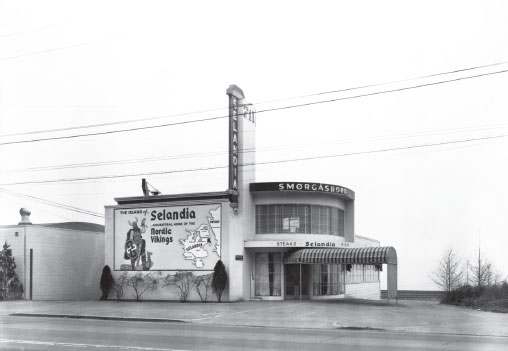
Not to be outdone, Selandia also had a tower with its name in neon and an awning-covered entrance. MOHAI, PEMCO Webster & Stevens Collection, 1983.10.16743.
For many years, the chef was Poppa John (real name, Themistokles Georgeos Karamanos), who in his early days had worked at the Brown Derby in Hollywood, California. The lunch menu featured salads of avocado and fresh Dungeness crab, shrimp louie, Dungeness crab louie, Dungeness crab omelet, crab and cheese dip, Dungeness crab on toast and cheese sauce and sliced turkey breast with bacon and asparagus spears topped with a house-specialty cheese sauce. Dinner entrées varied daily but often included braised sirloin tips, fried Pacific baby clams, prawns kebob Hawaiian and what a restaurant reviewer called “an astonishing array of seafood dishes”—oysters and crab, broiled salmon, grilled halibut, grilled filet of sole, prawns, scallops, lobster tail, shrimp and abalone. Somehow, steaks—from filet mignon to T-bone—also crowded onto the menu along with other non-seafood dishes. Today, the Marina Mart is still there; the Hidden Harbor is long gone.
Oyster Pepper Roast
½ green pepper, finely chopped
2 tablespoons olive oil
1 cup catsup
¼ cup water
2 tablespoons lemon juice
½ teaspoon Worcestershire sauce
1 dash soy sauce
1 dash Tabasco
50 to 65 oysters
Parsley
Toast points
Lemon wedges
In a saucepan, sauté finely chopped green pepper in olive oil until the peppers are tender. Add and blend 1 cup catsup, water, lemon juice, Worcestershire sauce, soy sauce and Tabasco sauce.
Add oysters to sauce and cook until done. Serve in individual casserole dishes garnished with parsley, toast points and lemon wedges.
Fresh Dungeness Crab Fry Legs
3 tablespoons butter
24 to 28 jumbo crab legs
1 ounce sauterne wine
20 large button mushrooms
Melt butter, add crab legs, wine and mushrooms and sauté for 3 minutes.
Marco Franco looks a bit uncomfortable surrounded by adoring waitresses in this 1956 photo. University of Washington Special Collections, JEW0422.
Moultray’s Four Winds was at 900 Westlake, at the southern end of Lake Union, and opened in 1955, a year after the Hidden Harbor. Chris and Bill Moultray built their restaurant atop a former 1900-era ferryboat called the City of Everett. The pirate theme—“Look for the Pirate Atop the Boat”—carried over inside the restaurant, where waitresses dressed in buccaneer costumes served up seafood, steaks and prime rib. Creoleseasoned dishes were a specialty. By 1965, the Four Winds had become the Surfside 9, a dance club. The following year, the bilge pumps that kept the old ship afloat failed, and the City of Everett sank to the bottom of Lake Union. It was raised but promptly sank again, this time for good.
The Wharf was part of the million-dollar Fishermen’s Terminal project constructed by the Port of Seattle and completed in 1952 at the south end of the Ballard Bridge. The Wharf Restaurant and Coffee Shop overlooked the fishing-fleet moorage, largest on the West Coast, and included a taproom and separate cocktail lounge.
Moultray’s was pirate country; a pirate figure atop the old ferryboat beckoned guests to board. There was also a Moultray’s in Yakima. Seattle Times.
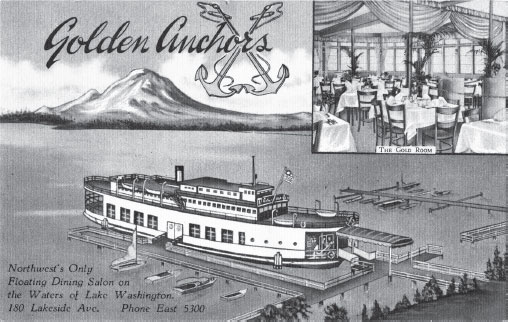
Golden Anchors sat atop the City of Everett, the same recycled ferryboat that later was used by Moultray’s Four Winds. MOHAI, Seattle Post-Intelligencer Collection, 1986.5.15.70.
It’s said that the Wharf had a split personality; Jack Curle, the manager, said he had two separate restaurants and cocktail lounges under the same roof:
They are served by the same kitchen, but each caters to a completely different clientele. On one side are the hard-working and roughly dressed commercial fishermen whose boats are moored nearby. The coffee shop and Moby Dick cocktail lounge cater to them, while the plush dining room and fancier Mermaid Room entertain more genteel family and club groups.
The Wharf grew over the years, eventually reaching a seating capacity of four hundred and becoming a popular nightlife destination, booking many musical acts and other entertainment. The Wharf made it into the 1980s before vanishing; today its place as Fishermen’s Terminal’s premier dining place has been overtaken by Chinook’s at Salmon Bay.
On the Lake Washington side of Seattle was the Golden Anchors at 180 Lakeside Avenue, near Leschi Park. It opened in 1945 aboard the City of Everett, the same ill-fated ferry that later carried Moultray’s Four Winds. Nearby residents were opposed to the idea of a dine-dance place operating in their quiet neighborhood, but the city eventually issued a license over their objections. Perhaps because it was afloat on fresh water, not salt, the Golden Anchor’s menu didn’t offer much seafood; typical fare included fried chicken, pot roast and sirloin steak. The Golden Anchors doesn’t seem to have lasted long; it was offered for sale after only a year and a half of business, and the old ferryboat was towed over to Lake Union to meet its ultimate doom.
QUEEN ANNE
Queen Anne Hill, one of the so-called seven hills of Seattle, defines the skyline two miles north of downtown. There are actually two Queen Anne neighborhoods: one at the south base of the hill around Queen Anne, Mercer and First Avenues and another at the top of the hill a mile farther north (and three hundred feet higher) along Queen Anne Avenue.
Lower Queen Anne developed first, as settlers cleared off the trees at the foot of the hill to build homes. Upper Queen Anne didn’t take off until a streetcar line built up it in 1902; before then, the grade was considered too steep and the hill too densely forested to be developed.
Restaurants began appearing in both Upper and Lower Queen Anne around 1930. The Queen Anne Cafe, at 15 Boston Street, atop the hill, had opened by that year. Also on Boston, on the west side past Queen Anne Avenue, was the Hill Top Cafe. Several restaurants owned by Lena Grollmund and Herman Peterson gathered at the top of the counterbalance (so-called as an assist to streetcars climbing the hill) to service hungry trolley riders. In the 1950s, the Red Snapper Cafe could be found at 1833 Queen Anne Avenue.
In Lower Queen Anne, Blanche J. and R.A. Matthews were the proprietors of Matt’s Log Cabin, a hamburger shop, in 1934. Matt’s was located at 435 Queen Anne Avenue. Another Queen Anne Cafe—no relation to the one on top of the hill—was run by Thomas Jensen at 527 Queen Anne in the 1940s. A restaurant called the King Grill, 605 Queen Anne, was in business in 1951. The entire character of Lower Queen Anne changed when the Century 21 Exposition came to town; located only a few blocks from the fair site and the iconic Space Needle, the neighborhood benefited mightily from the overflow business.
WESTLAKE AVENUE
Westlake Avenue originates in downtown Seattle and for many years was the main route north out of the city toward the Fremont, Phinney Ridge, Greenwood and Green Lake neighborhoods. Aurora Avenue and later Interstate 5 carry the bulk of north–south traffic, but Westlake remains an important arterial. Not surprisingly, a number of cafés and lunch places sprang up along Westlake, particularly in the light industrial district between Denny Way and Mercer Street.
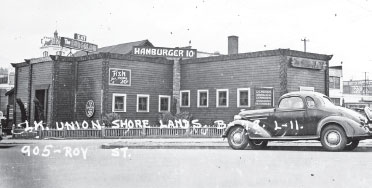
Built of logs and looking like a Wild West stockade, the Bungalow, at 905 Roy Street, disappeared long ago. Washington State Archives Puget Sound Regional Branch.
There were the Dart In Cafe, Roy’s Cafe and the Westlake Grill within a few blocks of one another. Just north of Denny was the E&B Cafe (later known as the J&K Cafe; it’s not known who E, B, J or K were). The Bungalow, a burger joint and tavern, was at 905 Roy Street, a block west of Westlake. It appeared in 1940 but was gone by the end of the decade. The sites of all these eateries have been overwhelmed by the explosive growth of the South Lake Union district.
FREMONT
Because Westlake Avenue hugs the east side of Queen Anne Hill in a narrow stretch of land along Lake Union, there wasn’t much room for restaurants to build up other than those actually on the waterfront. At the north end of Queen Anne Hill, Westlake merges with several other streets to cross the Fremont Bridge (built in 1917) into Fremont.
Even after being discovered and gentrified, Fremont (which modestly bills itself as “the center of the universe”) seems frozen in time; most of the buildings date to about 1910. The community grew with the early timber industry; it sits at the outlet of Lake Union, an ideal spot for sawmills. Once a separate town, it was incorporated into Seattle in 1891. During the heyday of streetcars, Fremont became an important intersection for trolley lines running north, south and east.
Over the years, a number of restaurants functioned in “downtown” Fremont, including the Metropolitan Cafe at the corner of Fremont Avenue and North Thirty-Fourth. The Fremont Drug Company originally occupied the building, but it had become a café by 1914. Now it’s a Starbucks. Just up the block was the Club Cafe. Around the corner where North Thirty-Sixth Street heads west to Ballard was the Spa Cafe, run by William and Verna Seder. In 1955, William Seder, despondent over financial problems, took his own life by turning on all the gas burners on the kitchen stove; before he did so, he saved his pet parakeet by taking its cage out onto an open porch. He was only thirty-seven years old. In later years, a typical neighborhood bar with live music occupied the Spa’s location; today, it’s a vegetarian restaurant.
Across the street from the Metropolitan stands a building that has been home to restaurants since at least 1910. It was first the Bryant Cafe; after a few years as a drugstore, it became Peggy’s Fountain Lunch and, in the 1970s, the Dancing Machine Tavern. Between 1981 and 2012, it housed Costas Opa, a fine Greek restaurant sorely missed by Fremocentrists, as the locals call themselves.
Next door on Thirty-Fourth Street was the Fremont Cafe, operated for many years by Nick Theotokis. A few feet east on Thirty-Fourth was the Aloha Cafe. North of Fremont, heading uphill toward Phinney Ridge, stood the Hob Nob Cafe at 4909 Fremont Avenue. In earlier days, it was called the Woodland Sandwich Shop; by 1968, it had become the Djakarta, an Indonesian restaurant. There’s an apartment complex at that location today.
PHINNEY RIDGE
Fremont Avenue intersects North Fiftieth Street; turn west onto Fiftieth, follow the road as it curves north a few blocks later and you’re on Phinney Avenue as it heads north to the Greenwood district. On the east side of the street is Woodland Park, one of Seattle’s largest parks and home to the Woodland Park Zoo. It was natural that cafés and lunch counters would go up near the park to take care of visitors; over a half dozen could be found along the ten-block length of Phinney Avenue bordering the park.
As early as 1928, there was a fountain lunch–hamburger place at 5409 Phinney; it later became McGrath’s Park View Lunch. The Woodland View Cafe was located at 5817 Phinney Avenue; Val’s Cafe, at 6020 Phinney, was just north of the park. The 1932 city directory listed Hans Romstead, John Manos, Paul Davison and Mabelle Patten as operating restaurants along this stretch of Phinney. (In those days, it was common for restaurants to be listed by the owner’s name.) All of these places have vanished.
Still standing at 6117 Phinney is the distinctive building long known as La Boheme. Looking like it was constructed in the front yard of a house, its English cottage–style design makes a distinctive sight. La Boheme opened soon after the end of Prohibition in 1934 and served a limited menu of hamburgers, steaks and chili—“the finest ever turned out by the hand of man.” Known to regulars as “La Bow,” it changed ownership in the late 1990s and is now Sully’s Snow Goose Saloon.
Another neighborhood favorite, recently closed, was at 6412 Phinney Avenue. In early days, it was known as the Snack Bar, but by the time Jeanne Mae Barwick took over in 1988, it had long been renamed the Phinney Ridge Café. Weekends found customers waiting on the sidewalk to get through the doors. Specialties included smoked salmon benedict, breakfast burritos, homemade cinnamon rolls and an unusual breakfast pairing called Shake and Eggs—a milkshake served with eggs done as you like ’em. Mae’s Phinney Ridge closed in 2013—another casualty on the dwindling list of Seattle’s classic cafés.
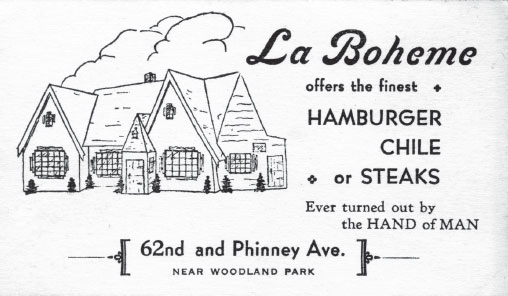
La Boheme, looking like an English cottage, could have been mistaken for a private residence. The building still stands along Phinney Avenue. Author’s collection.
Just up the street from Mae’s at 6557 Phinney, where the street makes a jog to the west and continues up Greenwood Avenue, a little café called Marian’s Lunch operated for a short time in the early 1950s. After a spell as home to various types of stores, the vacant building was purchased by Sharon and John Hughes and opened as a specialty restaurant called Eggs Inc. in 1970. The specialty was omelets—always cooked to order by either John or Sharon (while the other waited on tables), almost always with a line of customers waiting to get in, the place was so popular. The house favorite was called the Five-to-One: ham, black olives, mushrooms, cheddar cheese and onions. Other omelets had names like the El Paso, Barcelona, Bavarian, Canadian and Dungeness. Lunch-sized omelets were made with three eggs; five eggs went into the dinner version. Eggs Inc. eventually added other items to the menu for folks with dietary restrictions to eggs, including sandwiches, homemade pies and two new specialties: beef burgundy and chicken breasts in orange sauce.
What was Costello’s Cafe at 6724 Greenwood Avenue in 1951 became the Stumbling Goat Bistro. In the 1930s, Grace and Louis Perkins ran the Emerald Confectionery and Lunch at 6732 Greenwood. By 1968, it had become the 68th Street Tavern; until recently, it was the Kort Haus, a hamburger place. The building housing both the Stumbling Goat and the Kort Haus was purchased by real estate developers and is scheduled for demolition, though both restaurants hope to reopen in the new building.
Another burger place was Matt’s Hamburger, a small shop with only nine stools and two tables located at 7118 Greenwood. Matt’s was open twenty-four hours a day in 1936, when a fried chicken dinner cost just twenty-five cents. A few years later, it had become the Ridge Cafe; in 1951, it was called Lou La’s Grill. Later yet it was the Greenwood Cafe. An art gallery later occupied the premises.
In 1951, Noble’s Fountain Lunch was located at 7307 Greenwood; it later became the 4-Rs Cafe and, by about 1970, was the Harbin, Seattle’s first northern-style Chinese restaurant. The Harbin moved out, and the Greenwood Mandarin Restaurant moved in, with an extensive menu (over one hundred items) featuring special dishes such as palace beef, garlic chicken and princess chicken. The Greenwood Mandarin closed in 2014, and the building was demolished to make way for a bank branch.
Another location with a long restaurant history is 7419 Greenwood. John McGuirk was operating there as early as 1932. In the 1960s, it was Farrell’s Cafe, whose slogan was “Bring the Family for Sunday Dinner—Eat Better for Less.” For many years, it’s been Yanni’s Greek Cuisine.
GREENWOOD
The intersection of Greenwood Avenue and North Eighty-Fifth Street defines the Greenwood neighborhood’s business district. Over the years, several dozen restaurants have come and gone along this quarter-mile-long stretch of Greenwood Avenue; no old-timers remain, but many have appeared to take their places.
In 1930, Bill Fenton opened Creamland at 8402 Greenwood Avenue, when he was just eighteen years old. He worked seven days a week in the shop, often getting in at one o’clock in the morning to start making his ice cream. In 1958, robbers broke though Creamland’s back door and made off with $550, of which $374 was nickels—that’s over eighty pounds’ worth. After forty-seven years, taking only a single vacation during that time, Bill Fenton retired after scooping his last ice cream cone in October 1977. New owners Darryl and Pat Ryan took over for another dozen years and kept intact the old Creamland ambiance. Across the street was the Wee Hamburger Shop. After years of accommodating non-restaurant businesses, today the building is home to Kouzina, a Greek restaurant.
In 1951, the building at Eighty-Fifth and Greenwood, once occupied by the City Drug Store, was taken over by Randle’s Cafe. The name soon changed to Jacken’s Grill. Jacken’s featured full-course dinners in a family atmosphere with cocktails by an open fireplace in the Stardust Room, a separate lounge. In 1964, a complete steak dinner cost $2.50; prime rib was $3.00. Tuesday night was an all-you-can-eat smorgasbord from 6:00 until 9:00 p.m. Jacken’s was still Jacken’s in 1980 but a few years later became DiMaggio’s, where an all-you-can-eat salad and pasta bar—six choices of pasta, four different sauces—was priced at $5.95. Currently, the building serves as an events center called Greenwood Square.
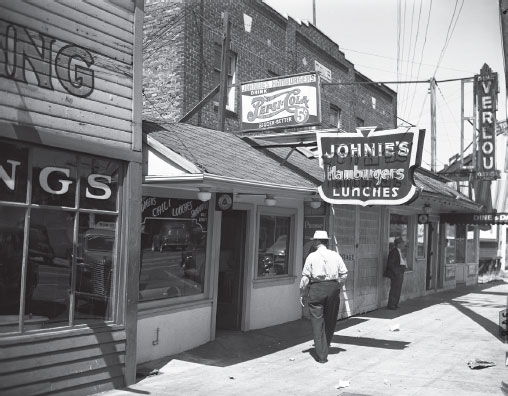
Johnie’s Cafe was shoehorned in between two buildings in Greenwood, just north of Eighty-Fifth Street. MOHAI, Seattle Post-Intelligencer Collection, 1986.5.12382.1.
There’s an interesting bit of hamburger shop history on the west side of Greenwood north of Eighty-Fifth. In the 1930s, John and Florence Ring operated Babe’s Hamburger Shop at 8601 Greenwood. They apparently sold the place in 1936 and moved a few doors south to 8635, where they opened Johnnie’s Hamburgers. One hundred feet farther along, but twenty years later in time, sat Johnie’s Cafe, a burger joint with nine stools and four booths, at 8523 Greenwood. If there was a connection linking Johnnie’s and Johnie’s, it’s been lost over time. Between them were a dine-and-dance place called Verlou’s and a Chinese restaurant, the China Inn.
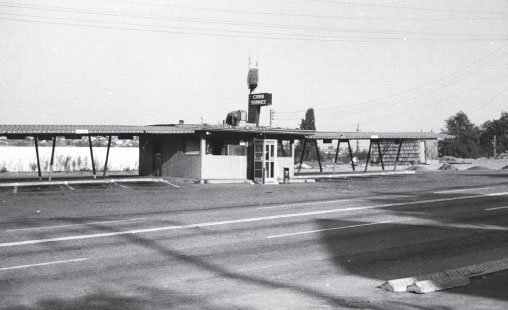
The Doodle Sack Drive-In, as it looked in 1956. “Doodle sack” is a slang term for bagpipes. Seattle Municipal Archives, 75756.
Marie Nordquist was the original owner and namesake of Marie’s Cafe at 8549 Greenwood. The story goes that she hired a cook from Oregon, a man named Harold Smith, who brought with him a recipe for blue cheese salad dressing that quickly became a house favorite. They began bottling the dressing in Marie’s basement for sale to customers, and its fame spread. In the 1950s, Smith bought the café from Marie, took on Werner Ferber as a partner and set up a bottling works to expand the salad dressing production. They marketed the dressings through several supermarket chains, and within a few years, the dressings business had far surpassed the restaurant, with over $1 million in annual revenues. Over twenty other varieties were offered, including creamy Italian garlic, thousand island and apple glaze, though the blue cheese dressing remained the most popular. Meanwhile, the café struggled along, running afoul of the liquor control board and health department numerous times in the late 1970s. By 1983, Marie’s had become the Baranof, still Greenwood’s favorite neighborhood bar. Marie Nordquist passed away in 2008. The dressings live on, though today they’re made in California, not Greenwood.
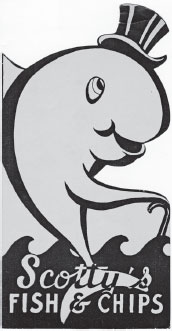
Scotty’s mascot fish was decked out in top hat and cane, as the cover of this menu shows. MOHAI, Seattle Post-Intelligencer Collection, 1986.5.15.90.
In 1951, a place called the One Hundred Per Cent Lunch sat in what is now the Safeway parking lot at 8728 Greenwood Avenue. Across the street and a block north was the Doodle Sack Drive-In at 9009 Greenwood. It lasted for about ten years before being replaced by apartments.
West on N Eighty-Fifth from the Greenwood Avenue intersection was Hazel’s Cafe. Scotty’s Fish & Chips was up the street at 323 NW Eighty-Fifth. Owner E.W. Robert “Scotty” Wylie operated his seafood place for sixteen years using a fish-and-chips recipe he claimed was handed down from father to son at the Cannon Mills Place Fish and Chip Shop in Edinburgh, Scotland. His menu also listed grilled halibut and salmon; fried filet of sole, shrimp and clams; and oysters in season. Around 1950, Scotty relocated to 8318 NW Eighty-Fifth, and the Fish Net Cafe went into his original location. Also along this section of Eighty-Fifth was a place called the Rattleyboo Cafe at 802 West. It apparently didn’t last long.
GREEN LAKE
Two business communities developed at Green Lake—one on the east side, another three-quarters of a mile away at the lake’s northern end. On the east side was Warling’s Restaurant at 7115 Woodlawn Avenue, a block away from the lake and adjacent to the Green Lake Theatre. Cliff Warling opened his restaurant, described as “the Northwest’s most modern and distinctive,” in 1949. That year, restaurant reviewer Nat Lund found Warling’s “a wise choice for folk in a steak-eating mood” with nine different varieties; top of the line were the New York–cut sirloin and porterhouse, which came with a tossed green salad, potatoes (baked, french fried or au gratin—a house specialty served en casserole with a mild cheese sauce), rolls and beverage for $2.75. Other broiler items included chops, lobster tails and Chinook salmon with melted butter. Filet of sole and butter-fried chicken served with hot baking powder biscuits and honey were also on the menu. Lund described Warling’s as a good lunch choice also, with decor “as tasty as the food—restful green walls, with stylized fish, and soft cove lighting” and a fourteen-seat bar with a mirrored ceiling and real bar chairs instead of stools. By 1969, Warling’s had become the Little Red Hen, which it still is today.
Just down the street from Warling’s, Raymond Buell’s Fountain & Grill was a prototypical neighborhood hamburgers-and-milkshakes sort of place. Burgers and a dozen different kinds of sandwiches were on menu along with short-order steaks, chili and fish and chips. An entire page of Buell’s menu was devoted to ice cream mixed drinks (shakes, malts, ice cream sodas and floats), sundaes, freezes and soft drinks. Buell’s also served limited breakfast fare: ham or bacon with two eggs (seventy-five cents) or a ham and cheese omelet for eighty cents. Buell’s was located at 7101 Woodlawn Avenue. A few steps away were two more lunch counter places: Green Lake Lunch & Billiards at 415 E Seventy-Second Street and the Green Lake Bowl Cafe on Ravenna Boulevard.
A block away from Buell’s, facing onto the lake at 7116 E Green Lake Way, was the Hula Hut Barbecue & Freeze. Although it had already been around for four years, the Hula Hut celebrated its grand opening in 1954 with nineteen-cent hamburgers, hot dogs, milkshakes and homemade apple pie courtesy of Peggy, formerly with the Green Apple Pie in downtown Seattle. Kids got free balloons and could enjoy a ride on the merry-go-round; leis and something called Hawaiian Freeze Pies enhanced the feeling of being on the islands. A 1971 fire seriously damaged the Hut, and it apparently did not reopen.
Palestine-born Saleh Joudeh arrived in Seattle by way of Italy in 1974, beginning his culinary career as a burger flipper at the nearby Green Lake Bowling Alley. A few years later, he took over a restaurant in the U District and renamed it Avenue 52. After a slow start, Saleh’s cooking began to garner rave reviews from local restaurant critics. In 1982, with his lease at Avenue 52 expiring, he moved to Green Lake and created Saleh al Lago (Saleh on the Lake). It is said that, at a time when most Seattleites’ concept of Italian food extended about as far as pizza, lasagna or spaghetti and meatballs, he introduced them to risotto, calamari and other classics of Italian cuisine. It was a sad day for Saleh’s regular clientele in 1999 when he was forced to close due to health issues.
At the north end of the lake was William Bryan’s restaurant, built in 1947 and originally called Bryan’s Fine Foods. By 1956, the restaurant had been renamed Bryan’s Lake Terrace Dining Room and made its mark on Seattle’s fine dining scene, featuring the freshest of seafood and steaks. Holiday dinners (turkey or prime rib) were long a tradition at Bryan’s, and reservations were a must-have on weekends. Bryan sold his restaurant in about 1960, but the new owners kept the name for a number of years. Bryan’s was located at 7850 N Green Lake Way.
MAGNOLIA
Northwest-bound out of downtown Seattle, Elliott Avenue runs along the bay for two and a half miles before turning north and becoming Fifteenth Avenue W on its way to Ballard. Just at the curve, the Magnolia Bridge carries traffic over railroad lines and port facilities up onto Magnolia Bluff and its small but prosperous business district, Magnolia Village. A couple of lunch counters were located here (the Magnolia Food Shop and the Magnolia Bowl Snack Bar, at 3212 and 3316 W McGraw, respectively), as well as a more upscale restaurant called Tenney’s. Verl and Alma Tenney, the owners and cooks, were well known for their homemade pies baked fresh daily: French apple, wild blackberry, pumpkin and pecan, among other flavors. By 1968, Tenney’s had become GG’s Restaurant, under management of Don and Clara Aust. Today, it’s an Austrian-themed steakhouse called Szmania’s. Tenney’s was located at 3321 McGraw. A few feet away at 3420 McGraw, and open as early as 1947, was the Village Grill, offering “good home cooking at moderate prices.” Still in business in 1960, it has since been replaced by a Chinese restaurant.
INTERBAY
Back on Fifteenth Avenue W, literally in the shadow of the Magnolia Bridge, in 1931 appeared what was billed as “a new concept in marketing”: the Mid-City Market, Seattle’s first drive-up shopping center. Today the idea of a supermarket or other large stand-alone store providing its own parking lot is taken for granted, but at the time, it was a revolutionary concept just beginning to become popular in California; until then, store patrons usually had to contend for street parking spaces in congested business areas. Under a single roof, with plenty of free parking, the Mid-City Market was home to a grocery store, meat market, dairy store, fruits and vegetables, even a service station—and Mrs. Helen Lea’s Mid-City Lunch restaurant. The Mid-City Lunch changed its name several times across the years and for awhile had a neighboring restaurant, the Cove Inn; both of them were still in business into the 1940s. (The Mid-City Market building still stands, though heavily modified, as the Builders Hardware and Supply Company.)
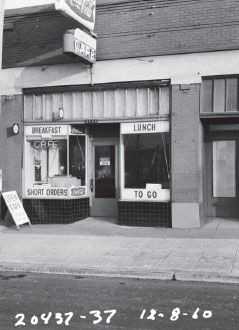
The M&J was a little storefront place, one of several along Fifteenth Avenue that catered to workers at nearby industrial operations. Seattle Municipal Archives, 65936.
Just north of the Mid-City Market were the Terminal Cafe and the Stewardess Cafe, facing each other across Fifteenth Avenue at 1601 and 1606 and marking the start of the industrial Interbay district with its massive railroad and shipping facilities. The appropriately named Interbay Cafe stood at 3053 Fifteenth Avenue; a few hundred yards north on the corner with Dravus Street was Hansen’s Café, and at 3204 was the M&J Cafe, typical storefront, short-order places catering to workers at the rail yard. The Fisherman’s Cafe, farther along on Fifteenth at the junction with Emerson Street, drew its customers from nearby Fisherman’s Terminal, home to hundreds of fishing boats and other watercraft.
BALLARD
Incorporated in 1890, Ballard’s early economy was based on sawmills and shingle factories and its access to open water (it sits on the north edge of Salmon Bay). By the time its citizens voted to be annexed by Seattle in 1906, Ballard had become a bustling town with a business district stretching along Ballard Avenue and a few side streets. Completion of the Ballard Bridge in 1917 brought Fifteenth Avenue across the Lake Washington Ship Canal about a quarter of a mile east of the original downtown; access from Fifteenth Avenue and the bridge to Ballard Avenue became more difficult after the bridge opened, and Market Street eventually developed into Ballard’s new downtown commercial district.
Ballard’s 1890 eating establishments included the Queen City Restaurant and Chop House and restaurants run by Burden & Linder, L.P. Levasseur, Carrie Rolff and Elizabeth McDonough. The Queen City Restaurant was still serving a decade later and had been joined by the Ballard Oyster House and the Home Restaurant. They had all disappeared by 1910.
One longtime resident of Ballard Avenue was the Owl Cafe & Tavern. The Owl opened as a saloon in 1904 and over the years was known by several different labels—saloon, café, tavern—and sometimes straddled the fine line of the law. In 1935, owner Emil Einess, aware of an impending police raid to seize his slot machines, called the department and told them not to bother—thieves had broken in the night before and stolen them. The Owl was still going strong in the 1980s as a bar with live music but had disappeared in the next decade after nearly one hundred years in business. The building that housed the Owl still stands, remodeled but basically intact, at 5140 Ballard Avenue.
Hattie’s Hat, another longtime survivor at 5231 Ballard Way, is the latest in a string of restaurants to occupy those premises. As early as 1924, Harry Pettyjohn was running a soft drink–lunch counter there. The Old Home Restaurant, under Bror Johnson and (later) Carl Anderson, was a longtime tenant. By 1955, it had become Malmen’s Fine Food, owned by Gus Malmberg, open twenty-four hours a day with cocktail service and “the mellow old Scandinavian flavor that made it a rendezvous for gourmet.” In 1971, Hattie’s moved in along with Aunt Harriet’s Room, the cocktail lounge. Forty-plus years later, Hattie’s remains Ballard’s favorite funky old-time restaurant. “Malmen” is still spelled out in small tiles on Hattie’s threshold.
In the early 1940s, Albert VanSanten had a restaurant at 5429 Ballard Avenue called the Vasa Sea Grill. (Vasa is Swedish for “ship.”) By 1952, a cocktail lounge, the Patio Room, had been added, and Francis King had been taken on as a business partner. King, the leader of a café orchestra in Seattle’s early days, played the violin in the restaurant until his death in 1956. The Vasa was another smorgasbord place—they called their version a Vasabord, available every Friday and Saturday evening from 5:00 until 9:00 p.m. and daily for lunch. The Vasa was still in business in 1979; today, the building is occupied by the Peoples Pub, a German restaurant.

The Home of the Green Apple Pie was located at 521 Pike Street. It’s unclear why a red apple, rather than green, was featured on the menu cover. MOHAI, 2009.86.1.
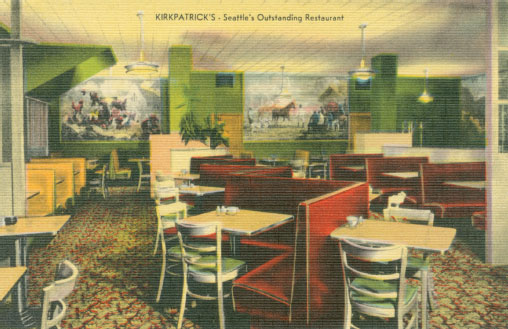
Earl Kirkpatrick was involved in many Seattle restaurants over the years. His biggest achievement was Kirkpatrick’s, at 416 Union Street.
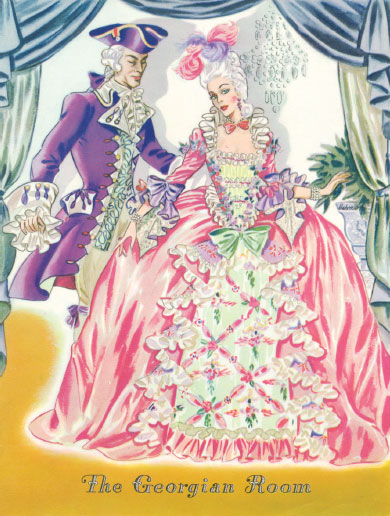
The Georgian Room in the Olympic Hotel issued a series of colorful menus featuring idealized scenes from eighteenth-century royal courts.

Maison Blanc was housed in an elegant 1880s mansion with another restaurant, the Rathskellar, in a basement building fronting Marion Street. In the upper-left corner is a vignette of owner and chef Charles Joseph Blanc. MOHAI, 2009.71.
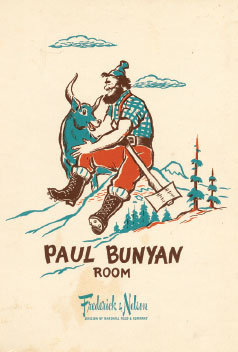
The Paul Bunyan Room was a 1960s addition to Frederick & Nelson’s food service, with Paul and his famous blue ox, Babe, portrayed on the menu cover. MOHAI, 1993.43_ box4_folder19.
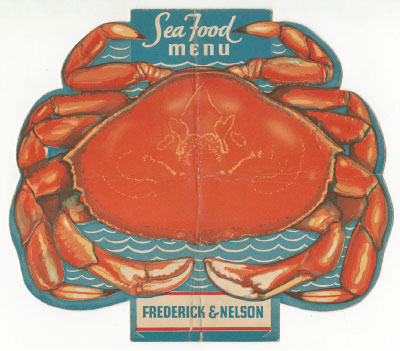
Frederick & Nelson’s Tea Room served much more than just tea, as the cover of this seafood menu illustrates. MOHAI, 2009.86.
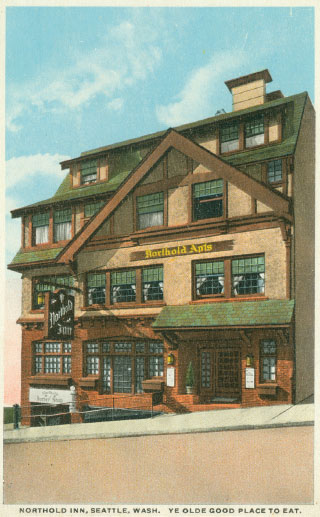
Claire Colegrove’s Northold Inn exuded the ambience of a Tudorstyle English inn with its half-timbered façade, dark woodwork and polished copper ornaments.
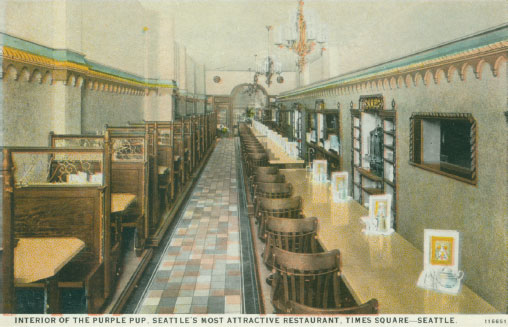
The layout of the Purple Pup, another Colegrove restaurant, was typical of its time: long and narrow with a counter and stools and booths lining the opposite wall.

This Triple XXX menu dates to the early 1920s—it lists Triple XXX cola (a short-lived product) along with the company’s mainstay root beer.
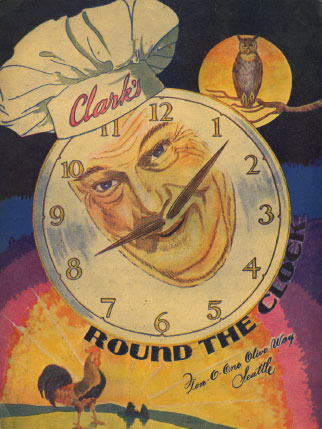
Day or night, Clark’s Round the Clock was always open at 1001 Olive Way. MOHAI, 1986.15.7.

A giant smiling fish served as a backdrop on Crawford’s colorful menu. Located right at water’s edge, Crawford’s guests had a great view of ship traffic on Elliott Bay.
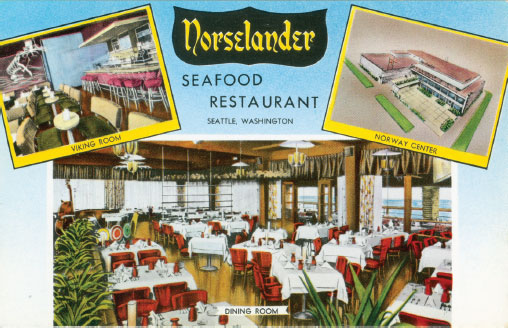
The Norselander, on the top floor of the Norway Center, featured an elegant dining room with cloth-covered tables and a high-level view of Elliott Bay.
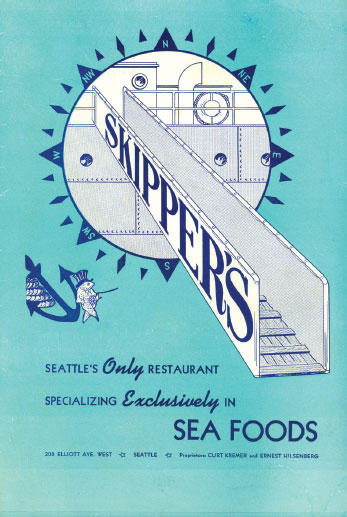
Skipper’s Galley played up the nautical theme. The restaurant was boat-shaped, and patrons walked a gangplank to get aboard.
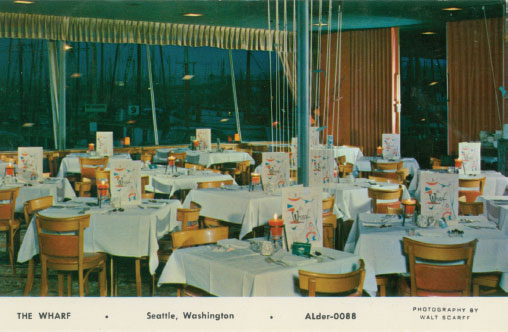
The Wharf was two restaurants in one: the upscale dining room seen here and a workingman’s café adjacent, both served from the same kitchen.
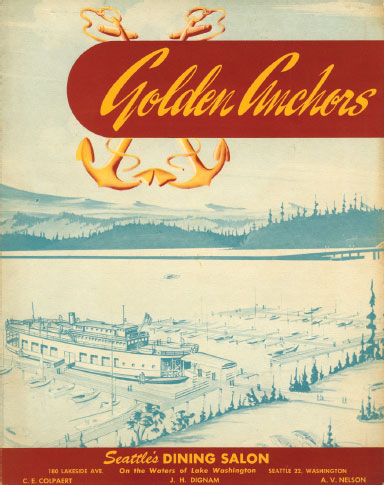
Moored in Lake Washington aboard an old ferry boat, the Golden Anchors was accessible off beautiful Lake Washington Boulevard. MOHAI, 1996.30.3.3.
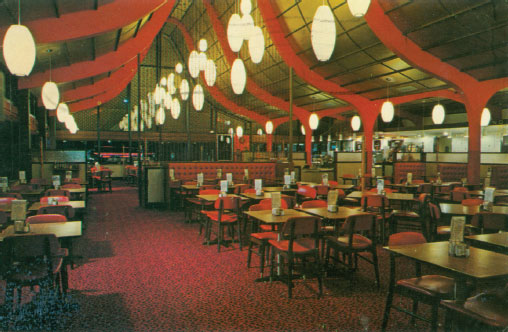
The interior of Manning’s, at the corner of Fifteenth and Market Street in Ballard, was the epitome of Googie-style coffee shop architecture in Seattle.
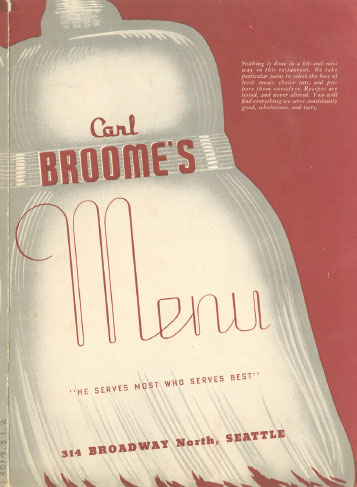
Carl Broome’s menu cover fittingly depicted a broom. This menu dates to the 1940s, after Broome had closed his Wallingford location. MOHAI, 2014.3.1.2.
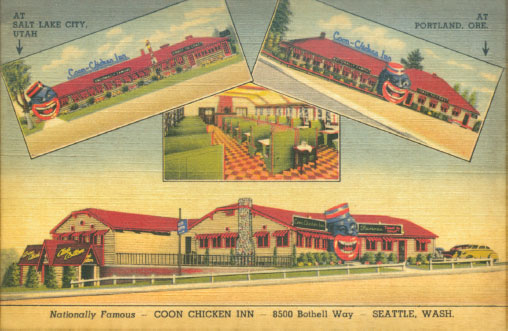
The Coon Chicken Inn, on Bothell Way, was one of a chain of three, the others (also pictured here) being in Salt Lake City and Portland.
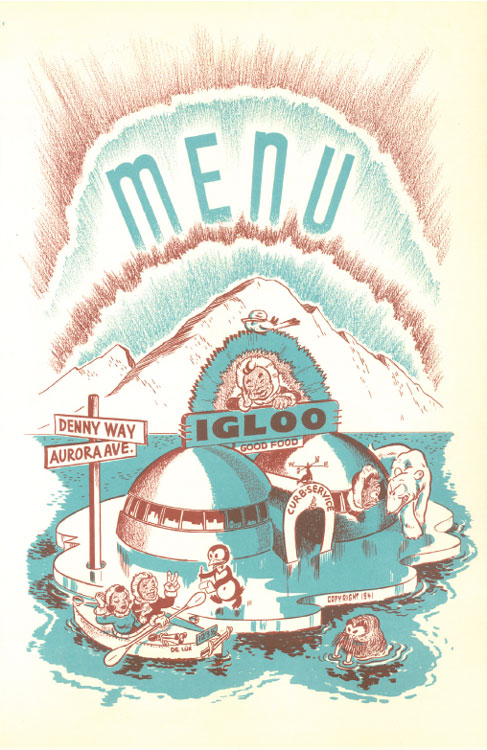
The Igloo floats on an icy island on this menu cover. A penguin takes an order from a drive-up boat while a polar bear roams the parking lot.
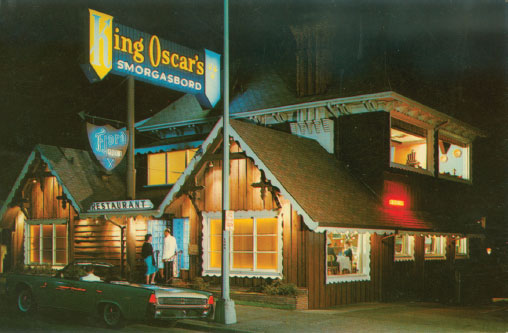
A well-dressed couple—she in furs, he in a tux—enters the warm glow of King Oscar’s on Aurora Avenue in this period postcard.
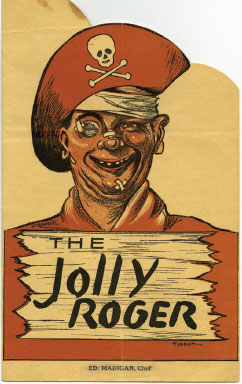
A pirate—looking the worse for wear—graces the menu cover of the Jolly Roger, a roadhouse on Bothell Way. UW, MEN036.

The cowboy-themed Bar-B-Q Chuck Wagon was also on Aurora, just north of King Oscar’s but a world away cuisine-wise.
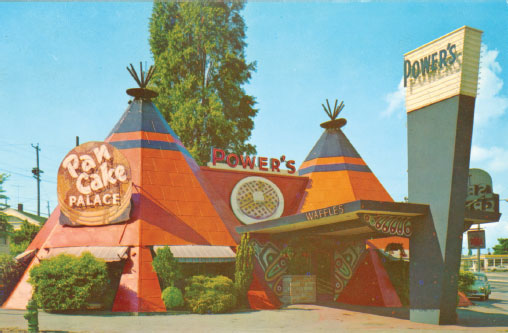
In later years, when Power’s Pancake Palace took over the Twin T-P’s, the gleaming steel teepees were painted orange and blue.

With a lovely señorita on the front and a dashing caballero on the back of its menu, Cook’s Tamale Grotto played up its Spanish essence.
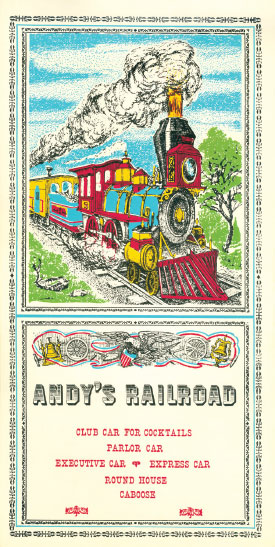
Andy’s Diner, housed in a set of repurposed passenger cars on Fourth Avenue South, took the railroad motif to the max with swizzle sticks shaped like train-crossing signs and paper engineers’ caps for the kids.
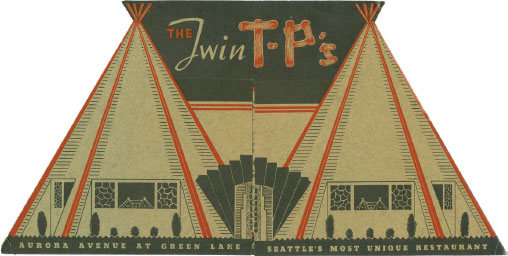
Once the crown jewel of Seattle’s roadside architecture, the Twin T-P’s opened in 1937 on Aurora Avenue (Highway 99) across from Green Lake.

Bob’s Chile repeated the Spanish theme a few years later, but this time the couple—slightly stylized—were dancing together on the menu cover. MOHAI, 1986.15.93.
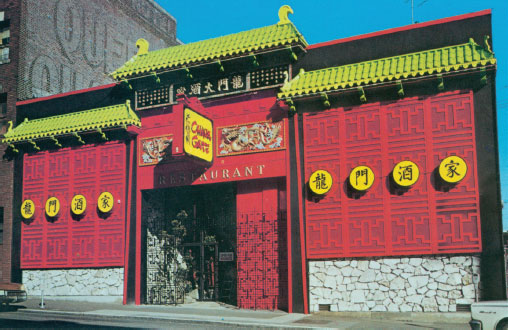
The imposing façade of the Gim Ling Restaurant (later the China Gate) loomed over Seventh Avenue South.

Trader Vic’s Outrigger in the Benjamin Franklin Hotel offered a colorful menu depicting idealized South Pacific scenes.

The China Pheasant was a dine-and-dance roadhouse on Highway 99; its menu was half American, half Chinese food items.

Bamboo partitions, thatched canopies above the tables and hanging bunches of bananas created an exotic atmosphere at the Kalua Room, in the Windsor Hotel at Sixth Avenue and Pike Street.
Elsewhere along Ballard Avenue were Blossom’s Lunch (also called the Corner Cafe and Bob & Nancy’s Cafe) at 5133 and the Swedish Kitchen at 5203 Ballard. The Fern Cafe, 4833 Twentieth Avenue, was a block off Ballard Avenue toward the water. The Fern specialized in hot cakes and waffles and put up lunches for workers along Ballard’s waterfront; it called itself “the home of the best T-bone steaks in town”—only forty-five cents—but seems to have been in business for just a few years in the 1930s. As early as 1907, there was a restaurant at 5203 Ballard Avenue; by the 1950s, it was called the Swedish Kitchen. In contrast to the already-developing persona of Ballard as a Scandinavian stronghold, Thomas Chinn had his Chung Sun Cafe at 5133 Ballard Avenue, where the Sunset Tavern is today.
John Kenney opened the Driftwood Cafe around 1936 at 5416 Fifteenth Avenue, a short block south of Market Street. By this time, Market (originally called Broadway) had become the commercial district and was the main route connecting Ballard with the Wallingford and University Districts to the east. The restaurant’s name changed a few years later—it became the Driftwood Inn—and by 1959, it had relocated to 1442 Market, still adjacent to the busy Fifteenth Avenue–Market Street intersection. Its advertising urged customers to “follow the crowds to the Driftwood Inn” for chicken, steaks, oysters and fish and chips served with courteous service in a pleasant atmosphere. Under Art Saulness’s management, the Driftwood became a bit upscale, with charcoal-broiled steaks and a variety of seafood dishes; they also introduced Ballard to pasties, the meat-and-potato turnovers brought to America by immigrants from Cornwall, England. After thirty-five years in business, Art and Marjorie Saulness closed the Driftwood Inn in 1979. Both of its locations are now parking lots.
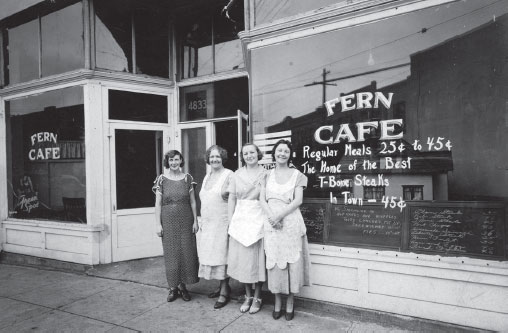
The entire staff took a break to have their photo taken in front of the Fern Cafe. Unfortunately, none of them are identified. Ballard Historical Society.
Summer 1947 saw Noble’s Chicken Dinner Inn open at 1718 Market Street, in the building now occupied by Don Willis Furniture. It became the Spud Nut Shop in 1951, “spudnut” being a potato-based doughnut sold by a chain of stores that originated in Salt Lake City in 1940 and grew to over three hundred stores (of which about thirty-five remain). In the 1950s, Mr. and Mrs. William Markham sold their Spud Nut Shop to Mr. and Mrs. G.B. Gore; it was gone by 1958.
On Twentieth Avenue, half a block north of Market, was the Plantation. Originally named Snyder’s Southern Food, its specialty was New Orleans French Creole cooking: marinated shrimp in remoulade sauce, Dungeness crab legs with cognac, poached halibut filet with lime-butter sauce and beef medallions with sauce Marchand de Vin. John Wilson was part owner; Willard Lillquist, the manager; Chef Barbara Sandoval studied haute cuisine for two years in Paris. The Plantation was still there in 1977; today, it’s the Golden City Chinese Restaurant. Another Creole-Cajun restaurant, Burk’s, was located a few blocks off Twenty-Second Avenue. Terry Burkhardt’s cooking was more rustic than fine French Creole, with emphasis on jambalayas, gumbos and étouffées. It closed in 2005.
Barbara Sandoval’s Crème de Cognac
Blanc mange base, or vanilla pudding to serve 4, prepared according to recipe except minus ⅓ cup of the milk
⅓ cup fine cognac, or 1 part Grand Marnier to 1 part fine cognac to equal ⅓ cup ¾ cup whipping cream, whipped
Shaved almonds
Cook blanc mange or pudding to thickened stage. Remove from heat. Stir in cognac or combination of cognac and Grand Marnier. Cool. Fold whipped cream into cooled pudding. Serve in 5-ounce brandy snifters with shaved almonds on top. Yield: 4 servings.
Farther along on Market Street was a cluster of short-order lunch counter places: the Hasty Tasty Snak Bar, at 5401 Twentieth Avenue just south of Market; Matt’s Hamburger, 2213 Market Street; Power’s Fountain Lunch, 2216 Market; and the Royal Cafe, 2307 Market, which in 1936 offered lunch for twenty-five cents and Sunday dinner for only forty-nine cents. The Roxy Cafe, at 2023 Market, went through several name changes over the years. Oliver Cummings was running a café at that address as early as 1934. At some point, it was called the Sunshine Dairy Lunch; by 1951, it had become the Chef Cafe. A trio of Southeast Asian restaurants now occupy the premises.
The Cream Inn Cafe appeared at 2311 Market Street in about 1940. It was owned by Folle and Hanna Pihl and is now a cocktail lounge called Hazlewood. The building next door at 2319 Market has a long restaurant history. As early as 1918, Lena Foster was running a restaurant at that spot. The building did a stint as a Dunlap Radio store until Albert VanSanten (later of the Vasa Sea Grill) opened an eatery there. Albert Selleck bought out VanSanten and ran Selleck’s Cafe there during World War II. By 1946, it had become Gunnar’s Cafe, owned by Bennet Blumlo; Elbert and Veronica Cope took over in 1957 and operated Gunnar’s for another ten years until they retired. Heavily remodeled, the building has been home to one of the Azteca Mexican restaurant chain’s locations for nearly thirty years.
At the western edge of downtown Ballard were Matt’s Cafe at 2409 Market (now Hamburger Harry’s) and Andy’s Cafe across the street at 2442 Market; Andy’s became Smitty’s when Chester Smith ran it in the 1950s. A quarter mile farther west, where Seaview Avenue curves north toward Shilshole Bay, the Totem House served up fish and chips. Somewhat modified (and with an expanded menu), it’s part of the local Red Mill Burgers chain. Across the street and of more recent vintage, Hiram’s at the Locks was an excellent place for steaks and seafood with a great view of boat traffic through the Ballard Locks. Hiram’s arrived in 1976, underwent a name change to the Pescatore Fish Café, reverted back to Hiram’s and finally closed in 2003.
A totem pole looms large over the Totem House, at the west edge of Ballard, in this 1955 photo. Seattle Public Library, spl_wl_res_00139.
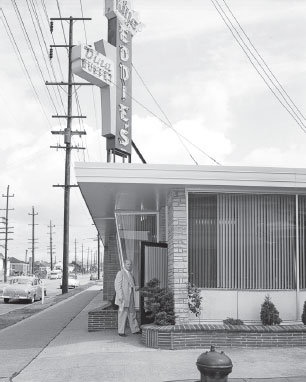
King Eddie’s Dina Buffet soon after it opened in 1954. It’s likely the man walking through the door is the king himself, Ed Davis. Seattle Municipal Archives, 78527.
On the east edge of Ballard, at the corner of Eighth Avenue where Market Street makes the long climb up Phinney Ridge, Ed Davis had a restaurant he modestly named King Eddie’s Dina Buffet. Ed was already known in Ballard for “the biggest hamburger in the world” and excellent steaks at the Davis Cafe, his place on Twenty-Fourth Avenue and Sixty-Seventh Street. In January 1954, the Seattle Times announced the opening of King Eddie’s “new eating establishment at 8th NW and Market Street.…Food that is fit for a king, queen, prince and princess will be ready day and night. Whether it is a steak or a snack, a dinner or a donut, King Eddie promises supremacy in service for 24 hours every day.” The new place was decorated “with the Mother Goose type caricatures of royalty,” and the house specialty was potpies. The King’s empire didn’t last long; it was apparently gone within a few years, and today, the Ballard Mandarin Chinese Restaurant occupies the former castle.
Back on Fifteenth Avenue, restaurants lined the street from the Ballard Bridge all the way to Sixty-Fifth Street, nearly a mile north. Just across the bridge, across from still-surviving Mike’s Chili Parlor, stood Peters’ Chanticleer at 4700 Fifteenth Avenue. Franklin and Ade Peters operated the Chanticleer for over twenty years before selling out in 1961 to Joe and Sharon Neyman. Originally from Butte, Montana, where pasties were (and still are) a popular lunch item, the Neymans possibly took a hint from the nearby Driftwood Inn and began making and selling pasties in their small café.
On the northwest corner of the Fifteenth Avenue–Market Street intersection stood one of the most distinctive pieces of roadside architecture in Seattle: Manning’s Cafeteria, part of the Manning’s chain of coffee houses, though the only one done in what is called the Googie style. Googie architecture originated in Southern California in the late 1940s (the name comes from a now-gone coffee shop in West Hollywood), and by the 1960s, Googie-style restaurants could be found throughout the country. Stylistic elements included upswept roofs, curved and sharply angled shapes and lots of glass and neon. The Manning’s building, designed by Bay-area architect Clarence Mayhew, was constructed in 1964. Sited where it was, at Ballard’s busiest intersection, it served as something of a greeting and gateway for residents and visitors. Manning’s operated from 1964 to 1983, served good food at affordable prices and became a gathering place for neighborhood regulars. After renovation in 1984, it reopened as a Denny’s. The doors closed in 2007, and despite vigorous opposition from preservationists, the building was demolished in 2008.
North on Fifteenth were the Three Sisters Cafe, the Red Robin Cafe and Fifteenth Avenue Fish & Chips. The Three Sisters Cafe, at 5912 Fifteenth, was earlier known as Liden’s Sandwich Shop. It later became an antiques store and today is the site of a Taco Bell. The Red Robin Cafe (not to be confused with the later Red Robin Gourmet Burgers chain) was located at 6117 Fifteenth Avenue in 1951. Fifteenth Avenue Fish & Chips, at 6409 Fifteenth where the street makes a slight jog on its way to Crown Hill, apparently didn’t last long, even with nearby Ballard High School as a potential customer base.
Leary Way, the connecting link between Ballard and Fremont, hosted a number of restaurants over the years: the Chat ’n Chew, just east of Ballard at 1440 Leary Way; the Cottage Cafe (also known as the Little Place), 3624 Leary Way, now home to Alberona’s Pizza & Pasta; the Cornell Cafe, 4302 Leary, where a hamburger stand was operating as early as 1939 and lasted until 1971; Birdie’s Cafe (later the Double VV Cafe), an “industrial lunch room” owned by Emma Tuckey in 1940, 4358 Leary; and Bergin’s Lunch at 5242 Leary—in 1973, it was the D&W, and today it’s the Señor Moose Café.
CROWN HILL
The Crown Hill neighborhood is centered on Fifteenth Avenue and Eighty-Fifth Street, another busy intersection of connecting arterials. In the 1930s, a small business district grew up around the intersection, of which a few buildings remain today.
A bit south of the intersection, at 8037 Fifteenth, was a place called the Twin Chestnuts. In 1946, owner Lawrence Simpier was robbed by a guntoting man wearing a child’s pink bandana for a mask. Kitchen worker Roy Parker tried to hit the robber with a glass of malted milk but missed and was shot at; luckily, he was only slightly injured. In the 1960s, it became McGrath’s Twin Chestnuts, open for luncheon and dinner only with “moderately priced home-cooked foods.” These days it is the Original Pancake House, an offshoot of the original Original Pancake House in Portland, Oregon.
At 8332 Fifteenth Avenue was Higgse Ice Cream Lunch, a hamburger shop–soda fountain place that vanished in the early 1950s. Next up were the Crown Hill Lunch and Christian’s, across the street from each other at 8505 and 8506 Fifteenth, respectively. The Fiesta Cafe, a dine-and-dance place owned by Peter Desimone, went in at 8517 Fifteenth shortly after the repeal of Prohibition; by the 1960s, it was a live music bar called Mr. P’s, and today it’s Centerfolds, an adult entertainment club.
The Harvester Restaurant began as the Brill & Spalding Tavern. In the 1960s, the Harvester advertised “delicious steaks, chicken, seafood served in pleasant neighborhood atmosphere” with cocktails in the Trophy Room. The restaurant suffered $200,000 worth of fire damage in 1979 due to faulty wiring of a stove hood and didn’t rebuild. Its site is now in the Value Village parking lot.
Another early place was Johnnie’s Hamburgers, 8521 Fifteenth. It’s mentioned in 1939 when it was held up at 2:15 one morning by two armed men—one with a gun, the other a knife—who ordered burgers and, when served, pointed a gun and robbed the cash register of about thirty-five dollars. It later became Johnnie’s Char Broiler, open twenty-four hours a day except Sunday, featuring rib-eye steak and eggs cooked the way you like them. Now it’s the parking lot of a Pizza Hut.
George Louie’s, possibly Seattle’s most far-flung Chinese restaurant in its day, opened in 1955 just off Fifteenth Avenue at 1471 Eighty-Fifth Street. In later days, George’s wife, Rose, recalled the locals being unfamiliar with Chinese food and that the Louies had to introduce them to this different, new cuisine:
When we first opened, people—the only Chinese food they are used to or knew about or would even bother to eat would be fried rice, chow mein, noodles, things like that. But gradually we expanded and included spicy dishes and more ethnic dishes. And people at first were skeptical, but they tried it and liked it. So we kept adding to it.
North of the Fifteenth–Eighty-Fifth intersection, Fifteenth Avenue becomes Holman Road and curves northeast to meet up with Greenwood Avenue. At the curve were three more eateries: the Coffee-Up Restaurant, at 9016 Holman; Little Acorn Cafe at 9053 Holman; and a different Crown Hill Lunch at 9081 Holman. They are all long gone.
LAKE UNION/FAIRVIEW
Fairview Avenue runs from the north edge of downtown Seattle to Lake Union through an area that, back in the day, was a zone of warehouses and light industry with a few scattered residences. Consequently, the restaurants were oriented to the working class. They included the Fairway Lunch Counter at 204 Fairview; the Fairview Cafe, owned by Blodwen “Bobbie” Blomquist on the corner of Fairview and Mercer; and Messmerized Chicken ’N Chips, 609 Fairview. The Little White Kitchen was in business under Victoria Bourgault’s management as early as 1933 at 713 Fairview. Next door and twenty years later, Modesto and Joseph Colasurdo had their M&J Cafe; it later became the B&A Cafe and went out of business in 1976. To the northeast, where Fairview merges with Eastlake after a short run along Lake Union, was the Lake Union Cafe (the original, not the same-named place a mile to the north these days).
EASTLAKE
A route of the early Pacific Highway, Eastlake Avenue was a major thoroughfare into and out of Seattle. Northbound from downtown, the highway passed through several distinct neighborhoods—Eastlake, the University District and Roosevelt—before turning northeast onto Bothell Way (Lake City Way today) and eventually to Everett and points north.
There were a few small cafés along Eastlake near its junction with Fairview. A lunch room at 1206 Eastlake, opened in the 1920s, became the Baum Cafe under Hazel Baum’s ownership. Just up the street was the New Shamrock Cafe, another early lunch place that lasted into the 1950s.
Another complicated thread of Seattle restaurant history: in the late 1940s, Les Teagle opened a restaurant at 304 Eastlake Avenue. Around 1955, he sold it to Harold Frye and found a new spot along Aurora Avenue. Frye renamed the Eastlake Avenue location, calling it Harold Frye’s Charcoal Broiler, and happily served lunch and dinner (and cocktails in the Sage’n Sand Room) until 1960, when it was taken by freeway construction.
Undeterred, Frye found a waterfront location on Lake Union at 2501 Fairview and opened Harold’s Satellite (the “satellite” moniker was chosen in keeping with the space theme of the upcoming Expo 21 fair). On the menu were seafood kabobs, lobster tails, salmon steaks and other seafood specialties, along with the usual steaks and prime rib. Unfortunately, Frye didn’t prosper in the new location; the Satellite closed after about two years, though Frye went on to open yet another restaurant in North Seattle. The vacant Satellite was purchased by Roy Myers, previous owner of the Richelieu Cafe in downtown, and renamed the Riviera. In 1969, it became the Hungry Turtle and was later known as the Landing.
On a slight rise overlooking the University Bridge, just off Eastlake at 3272 Fuhrman Avenue, was the first restaurant in the chain of Red Robin Gourmet Burgers. The story is told that its history began with Sam’s Tavern in the 1940s. Sam, the owner, sang in a barbershop quartet, and one of his favorite songs was “When the Red, Red Robin (Comes Bob, Bob, Bobbin’ Along).” He liked it so much that he changed the tavern’s name to Sam’s Red Robin. While it makes for a good yarn, it doesn’t appear to be accurate. As early as 1930, the Bridge Cafe—it later became Bee’s Corner Cafe—was at this address, and a 1942 classified ad announced that Tommy Dace, well known in local musical circles, “must sell the Red Robin, 3272 Fuhrman Avenue.”
Whatever the facts, it’s certain that Red Robin was a well-established name by the time Gerry Kingen purchased it in 1969. A newspaper comment of the day captures the Red Robin’s early ambience: “very old-tavernish; loud jukebox, a line of hunched shoulders and long hair at the bar; at the tables a mix of old-timers and college kids just discovering the place,” with the scent of marijuana detectable, particularly on the open balcony that overlooked the Ship Canal.
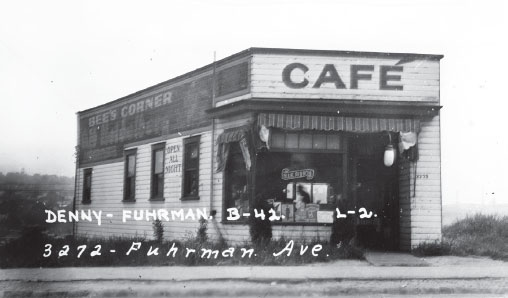
Bee’s Corner Cafe occupied 3272 Fuhrman long before the first in the Red Robin chain took over in the late 1960s. Washington State Archives Puget Sound Regional Branch.
It wasn’t until the mid-1970s that Kingen started to serve hamburgers—at first only the usual varieties, but eventually offering twenty-eight different types of burgers—and the place exploded in popularity. Kingen began selling Red Robin franchises; a second Red Robin opened in Yakima in 1979 and another in Portland the following year. By 1985, the Red Robin chain included 175 restaurants and corporate headquarters were moved to Irvine, California. Today, the total number of Red Robins worldwide tops out at over 500 locations.

The first Red Robin, progenitor of the chain, as it looked circa 1970. Washington State Archives Puget Sound Regional Branch.
While all this explosive growth was happening, the original Red Robin in Seattle continued dishing out burgers to a steady clientele—until the corporation decided that the building was too out-of-date and not worth rehabilitating. It closed in 2010, and the building was removed.
UNIVERSITY DISTRICT
Eastlake Avenue becomes Roosevelt Way after crossing the University Bridge. Half a mile to the east is the University of Washington (UW) and the aptly named University District. When the UW relocated from downtown Seattle to take advantage of buildings left by the 1909 Alaska-Yukon-Pacific Exposition, this lightly populated area was known as Brooklyn. It didn’t take long for the university to bring explosive growth to the neighborhood.
In short order, a mile-long business district of restaurants, clothing stores and movie theaters had sprung up along Fourteenth Avenue (soon to be renamed University Way, commonly called the Ave) to service students and faculty. Dozens of cafés and lunch counters fed hungry students on the run between classes. A few fine dining places intermingled with the cafés, and two hotels anchored the northern end of the district.
At the southern end of the district were such places as the Portage Bay Grill, the Snack Shop, the U&I Cafe and the Club Cafe. At 4136 University Way was an outlet for a small local chain called Fabulous Burgers, which had five other locations around the city. In 1953, fifty cents would buy “two of the most fabulous hamburgers you ever ate”—quarter-pound hamburgers, each on a large bun with onions, lettuce, tomatoes and a thick slice of Tillamook cheese. Howard’s Restaurant was a typical storefront eatery at the corner of Forty-Second and the Ave. Just up the street were Opal’s Grill and Harvey’s Kitchen.
Among the earliest eateries was the Olympia Cafe at 4003 University Way, in business since at least 1932 with frosted refrigerator pipes spelling out the café’s name in the front window and an old-fashioned “Booths for Ladies Only” sign on the door. Longtime owners George Apostolou and John Soldano were legendary for feeding hungry and sometimes penniless students; noted architect Victor Steinbrueck recalled that, when he was a student, “George and John always made certain we had plenty to eat, really loaded us up on mashed potatoes and gravy, plus big portions of meat and crusty bread—stuff that really stuck to your ribs.” The price? Thirty-five cents. Steinbrueck remembered the Olympic as “real, not synthetic—something difficult to find these days,” but even in 1965, it was one of the last remnants of an earlier generation of restaurants. The Olympic was the last restaurant on the Ave to sell meal ticket books.
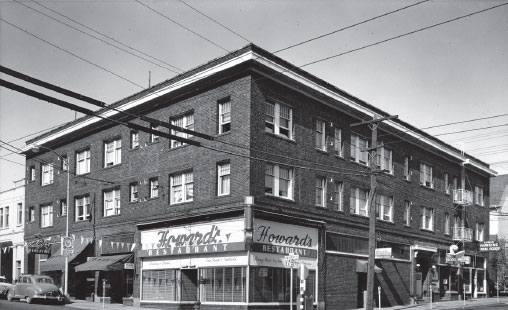
Howard’s was one of several dozen restaurants along University Avenue catering to students and faculty from the nearby University of Washington. University of Washington Special Collections, SEA3554.
The greatest concentration of restaurants on the Ave was along the twoblock stretch between Forty-Third and Forty-Fifth Streets. The Columns Cafe was at 4302; opened in the late 1940s, it was gone by 1965. Next door was a hamburger stand called Rod & Dean’s. The Lun Ting Cafe, at 4318 University, featured barbecued spareribs, egg rolls, won ton soup and almond chicken and was open only for dinner. Near the busy intersection with Forty-Fifth Street was a group of fountain lunches: Leo’s Fountain Cafe at 4342 University, Norm’s Fountain at 4344 (now occupied by Bartell Drugs, which had its own fountain service) and Graham’s Restaurant & Fountain at 4701 University Way.
Farther along the Ave as it headed toward the Ravenna neighborhood, Hasty Tasty Cafe (5247 University) was a favorite for hamburgers and milkshakes. By 1980, it had become Avenue 52, a restaurant that combined Syrian and Italian cuisine. On the menu were fettuccine, chicken Bolognese and other Italian dishes, along with Syrian specialties such as shish kabob and “upside down” chicken (layers of boneless chicken, deep-fried cauliflower and seasoned rice). Avenue 52 closed when owner Saleh Joudeh moved to Green Lake to open Saleh al Lago.
Among the fine dining spots on the Ave were Lee’s Broiler and the Robin Hood Grill. Lee’s, at 4553 University, occupied a spot previously home to Sandy’s Grill. In 1956, a seven-course steak dinner cost $2.15; the sauerbraten dinner was $1.55. Lee’s was open for lunch and dinner, “a continental flavor in an intimate modern atmosphere,” with original broiled specialties served Oriental style. When the state legislature changed the zoning for the U District from dry to wet in 1967, Lee’s was the first restaurant on the Ave to be granted a liquor license. Still in business in the mid-1980s, today a Starbucks fills the space where Lee’s was.
The restaurant at 4334 University had several names over the years. As early as 1923, A.G. Wilds and Roy Hosfield were running the Al Roy Restaurant there. In the 1940s, it was Dick Wiseman’s; a few years later, it was Ken’s Hamburger Shop. It went upscale in the mid-1950s as Cherberg’s Chimes and, later yet, the Robin Hood Grill, with a menu of steaks and entrées (five different types of steaks along with pork chops, veal cutlets, beef liver and bacon and spaghetti); sandwiches, including the house specialty Robin Hood’s De Luxe Hamburger (lettuce, tomato, mayo, olives on a toasted bun) and clubhouse, minced ham, chicken salad and grilled chicken sandwiches; breakfast; and full fountain service with sundaes, milkshakes and soft drinks.
In 1923, an elegant apartment hotel, the Wilsonian, opened at the corner of University Way and Forty-Seventh Street. The seven-story brick and terra-cotta structure offered ninety-nine rooms of various levels of luxury aimed at attracting both long-term residents (many of them on the faculty of the university) and overnight guests. Helen Swope of tearoom fame managed the Wilsonian’s two dining rooms—the main room, the Peacock, and a smaller Italian-themed dining room called Via Fontana. Within a year, the Peacock Room—“its decorations and furnishings daring in the extreme, yet in compete harmony…a series of moderate-sized rooms afford privacy without the shut-in feeling of the ordinary restaurant dining room”—had become the social center of the University District and was a favorite destination for holiday dinners.
Helen Swope parted ways with the Wilsonian in 1931 to assume management of dining room services at the new Edmond Meany Hotel, located two blocks away at Forty-Fifth and Brooklyn. The Wilsonian’s Peacock and Via Fontana dining rooms became casualties of the Depression; the Wilsonian was sold in 1939, but a café continued operating there into the 1950s. The Edmond Meany is now known as the Hotel Deca; the Wilsonian still stands but is not in business as a hotel.
ROOSEVELT
In days prior to Highway 99 and Interstate 5, Roosevelt Way was a main thoroughfare for traffic northbound from Seattle toward Bothell and Everett. Just north of the University Bridge, a number of roadside cafés sprang up near the busy junction of Roosevelt and Forty-Fifth Street, the main arterial connecting the University District with Wallingford and Ballard to the west. Bess N’ Nita’s Tasty Nook was at 4109 Roosevelt in the 1950s. At 4228 Roosevelt was the Crab Spot, which later became Campos, operated by Danny and Abel Campos and billed in 1961 as “the only Texas-Mexican style restaurant in Seattle.” The Campos brothers learned the restaurant business from their father and had all his recipes, along with the spices and other ingredients “that makes Texas style different from other Mexican foods.” Chicken and guacamole tostadas were a specialty; décor included serapes on the walls and an Aztec sundial plate.
D-Lux Hamburger (later called Kirk’s Burgers) was located next to Campos. Up the street at 4526 Roosevelt was the Blue Moon Cafe (not to be confused with the nearby and still-extant Blue Moon Tavern). A few doors away was the Red Rooster Cafe; opened in 1939 and operated by Frankie France and Irene Ledwich, it later became Chester’s Cafe. Across the street was the Auto Row Cafe at 4551 Roosevelt Way, and two blocks farther north was the Nifty Nook, an eleven-stool restaurant later known as Goldie’s Cafe.
Several other eateries were scattered alongside Roosevelt Way as it continued north. For nearly twenty years, Greek immigrant Peter Anastos had Pete’s Barbecue at 5300 Roosevelt; it later became the Maple Inn and today functions as Dante’s Tavern. Two drive-ins, Ronken’s and the Hamburger Round-Up, were a few blocks north. By 1965, the Hamburger Round had become the Taj Mahal Restaurant. It was located at 6106 Roosevelt.
By the 1920s, a business district had risen at the intersection of Roosevelt and Sixty-Fifth Street, and locals and highway travelers had a number of restaurants to choose from. There were the Roosevelt Coffee Shop at 6417 Roosevelt Way and Lloyd’s Lunch at 6503 Roosevelt, in business as early as 1934 under H.J. Lane and lasting into the ’50s. Clement Arnold had the Rainbow Cafe at 6409 Roosevelt; it later became a Chinese restaurant called the Ming Garden. Another café-turned-Chinese-restaurant was at 6510 Roosevelt; first called the Hollywood Cafe, by the 1950s, it had transformed into the Far West Cafe. H.T. “Ted” Holmes ran De Luxe Hamburgers at 6603 Roosevelt; in addition to burgers, he was well known for his chili. By the mid-1940s, the thirty-nine-seat B-29 Cafe could be found at that address.
The district’s premier eatery, as well as one of the earliest, was located at 6521 Roosevelt, where a café was in business by the mid-1920s. By the next decade, it was known as the Wayfair Cafe, owned by Lynette Perry. Egyptian-born Abraham Nakla bought the place in 1947, remodeled it and reopened it as Abie’s Grill. “World famous chef Abie,” as he liked to describe himself in ads, specialized in $0.85 dinners with a choice of baked spareribs, steamed wieners with sauerkraut, grilled hamburger steak, minced ham omelet, grilled liver and bacon, Columbia River smelts, fried oysters, grilled salmon or halibut steak. Also on the menu were roast beef, pork, turkey, baked chicken, baked ham and a full-course steak dinner for $1.50. Abie’s was always open for breakfast—egg dishes, omelets, French wheat cakes and waffles.
In 1948, Abie sold his Roosevelt location and opened a new place just east of the University of Washington in the new Laurelhurst Shopping Center on E Forty-Fifth Street. A colorful character, Abie continued to offer full dinners at moderate prices until his passing in 1959. After Abie departed Roosevelt, the restaurant’s name reverted to the Wayfair Cafe, with “lots of good food at modest ‘family’ prices.” Fred and Pat Garski became involved in the restaurant, and by 1951, it had been renamed Garski’s Scarlet Tree. Remembered as “a relaxed, friendly atmosphere [that] provides the perfect setting for enjoyment of dinner, luncheon, cocktails or late evening suppers…a Northeast Seattle tradition,” the Scarlet Tree served up steaks, full-course dinners, luncheons and cocktails. Two-for dinners were a specialty; the menu offered a choice of regular full-course dinners starting at two for $5.90. Top of the line were steak and lobster dinners priced at two for $10.90 in 1974.
Just north of Sixty-Fifth Street, at 6815 Roosevelt, was the Marnex Drive-In. A Triple XXX Root Beer barrel originally occupied the spot but was torn down in 1940 when the owners chose to open a new Triple XXX on Bothell Way, half a mile north. The Marnex took over the site a few years later; initially a typical drive-in vending $0.19 hamburgers (five for $0.50 with special coupon), milkshakes for $0.19 and a side of french fries for $0.11, by the mid-1950s, the Marnex had evolved into a full-service restaurant with four different steak dinners—filet mignon, club steak, T-bone or ribeye—ranging in price from $1.00 to $1.65 and a “complete fountain and restaurant menu.” Renamed Bojack’s Restaurant by 1962, it suffered a major fire that year and apparently never reopened.
WALLINGFORD
Wallingford’s compact commercial center grew up astride the trolley line that once ran west along Forty-Fifth Street from the University District before turning south on Stone Way en route to downtown Seattle. Over the years, numerous restaurants intermingled with clothing shops, hardware stores and several movie theaters. At the west end near the Stone Way intersection were the Forty-Fifth Street Cafe (1224 N Forty-Fifth Street), the Wishbone Cafe (1304 N Forty-Fifth) and the Tip Top Sandwich Shop (1400 N Forty-Fifth).
At 1403 N Forty-Fifth Street was Broome’s Aristocratic Hamburger Shop, which had the dubious distinction of having been bombed twice in 1935 during a time of labor troubles. Owner Carl Broome rebuilt and within a few years opened two more shops, one on Queen Anne Avenue and another on Broadway. A few blocks farther east were the Chili Bowl Cafe at 1605 N Forty-Fifth and the Green Lantern Cafe and Gus’s Steak House at 1618 and 1624 N Forty-Fifth Street, respectively.
Lawrence and Doris Gurney ran Larre’s Bar-B-Q in the 1950s, serving up barbecued beef, ham, pork and spareribs for lunches and dinners. Larre’s was at 1718 N Forty-Fifth. It later became a Mexican restaurant, the Guadalajara. The Little Wonder Grill was in business at the same time as Larre’s at 1927 N Forty-Fifth. Near the historic Guild Forty-Fifth Theatre were the Dixie Cafe and a place called Joe’s Snacks in the building now occupied by the Iron Bull Sports Bar at 2121 N Forty-Fifth. Marking the east end of Wallingford, Even’s Cafe (later the Chung Mee Cafe) stood at 2301 N Forty-Fifth; across the street was the Little Kit Kat Drive In.
MADISON STREET, THE CENTRAL DISTRICT AND MADISON PARK
Madison Street is the only thoroughfare out of downtown that touches the shore of Lake Washington, running southwest–northeast all the way from Elliott Bay to the lake. Today, it is heavily used by residents of the Capitol and First Hill neighborhoods as well as by commuters wanting to bypass the Interstate 5–State Route 405 bottleneck by getting onto the Evergreen Point Floating Bridge (officially the Governor Albert D. Rosellini Bridge) at Montlake.
What is now a major arterial street had its beginnings as part of a real estate development. Even early in the city’s history, Seattleites were making the adventurous three-mile trek from downtown to a pleasant picnic ground and recreational spot on the edge of Lake Washington. In the 1870s, John McGilvra purchased several sections of land in that area for a homestead and had a road constructed to downtown. The rough-cut road became Madison Street, and the old picnic grounds became Madison Park. By the 1880s, a ferry was in place transporting people and freight from Madison Park across the lake to Kirkland. With the rise of the auto age, the ferry route became part of the Yellowstone Trail, one of the country’s earliest cross-continental routes. Even after the 1940 construction of Lake Washington’s first floating bridge (common name: the I-90 or Lake Washington Floating Bridge; real name: the Lacey V. Murrow Bridge), the ferry remained in service for another ten years.
Restaurants began appearing on Madison, particularly at two neighborhoods along the way: the area between Twenty-First and Twenty-Third Avenues and at its terminus at Madison Park, where quite a commercial district had developed around the ferry landing. There was the Columbus Malted Milk & Sandwich Shop at 1010½ Madison, just east of downtown; it later became the Lock Yuen Cafe. The Tank & Tummy—part café, part tavern—spent about twenty years at 1208 Madison. Across the street was a place that began as Wila’s Delicatessen. Robert Harris bought it in the early ’60s, renamed it Bob’s Cafe and served “delicious breakfasts, luncheon and dinner in congenial surroundings. Luncheons at $1.25…Filet steak sandwich $1.95.” Bob’s also had a cocktail lounge and banquet facilities.
The Terminal Chop House, another early place, was at 1335 E Madison in 1932. Opposite it across Madison was the Fourteenth Avenue Coffee Shop, 1336 E Madison. Jack MacDougall opened it as a tavern in 1933. In later years, it was owned by Panos Nikolopoulas and Gus Charouhas. The Drum Room Grill was in the same block at 1342 E Madison. It opened prior to 1951 and for a time was owned by Harold Frye, who had several other restaurant interests around the city. Irving Stept was the proprietor in 1966; the same year, the name was changed to Sol’s Broiler, but not for long—by the next year, it had become Zed’s Broiler Restaurant before reverting back to the Drum Room again. It disappeared circa 1978.
A.R. Smith had a lunch counter called Smitty’s Lunch at 1412 Madison as early as 1932. Gordon Sawdy bought it the following year and was still running it a decade later. It was the Taxi Lunch in 1951 and Vi’s Cafe three years later. The Cottage Cafe, at 1501 E Madison, was originally owned by Julius Hansen. By 1973, the Cottage was being run by the same Robert Harris who operated Bob’s Cafe a few blocks back west on Madison. That same year, Harris was shot to death there; four years later, another murder took place at the Cottage. Still in business in 1978, it is now long gone.
The quarter-mile-long stretch of Madison between Twentieth and Twenty-Fourth Avenues is part of the Central District, for decades a focus of residency for Seattle’s black population. Nearly a dozen restaurants and taverns lined Madison in this area. Jimmie’s Cafe was at 2004 E Madison. Marion C. Honeysuckle owned the Honeysuckle Recreation and Cafe, 2030 E Madison. Thrasher’s Cafe, 2038 E Madison, later became the Casbah Tavern. Floyd Strickler had a card room and tavern at 2047 E Madison in the 1940s; by 1954, it had become the Mardi Gras and was still in business there in 1984.
The Lincoln Cafe and the DeLite Lunch were early eateries in the 2100 block of E Madison, dating to 1932. Charles Barber had a lunchroom at 2229 E Madison in 1940; Carter T. Dawson later purchased it and ran it as Evelyn’s Restaurant. In 1972, what had been Trilby’s Grill at 2310 E Madison became Willie’s Smokehouse. Willie McClenon, a semi-pro football player, renovated a burned-out restaurant with the help of a smallbusiness loan. He installed new booths, counters and a large brick barbecue oven. Willie’s specialties were hamburgers, ribs, french fries, chili, ham and eggs, sandwiches and homemade sweet potato pie. For a dozen years, Oscar and Betty Ryan ran Betty’s Cafe at 2703 E Madison. Practically all of these places have vanished.
Out toward the end of Madison, in the posh Broadmoor neighborhood, was Nino’s Cafe at 4106 E Madison. For a while, there was a soda fountain inside the Broadmoor Pharmacy at 4130 E Madison. The very end of Madison Street at Madison Park supported nearly two dozen businesses during its peak years, including the Bamboo Terrace (4226 E Madison) and the Quality Cafe (4226 E Madison). On Forty-Third Street, which cuts across Madison at its very end, was an early restaurant run by Shields & Hutcheson. Guppy’s Fish & Chips, at 1927 Forty-Third N, was just across the street; and to the north, right on the lake, was an elegant place called Elona’s Lake Crest Inn. Elona’s fixed-price Thanksgiving dinner in 1929 included two seafood cocktails—oyster and crab; creamed chicken consommé; choice of stuffed turkey, roast goose or fried chicken for the entrée; choice of potato (mashed, creamed or candied sweet potato); cauliflower Polonaise; English-style plum pudding with hard sauce; choice of dessert (mince pie, pumpkin pie or Lake Crest apple pie) and ice cream; fresh fruit and nuts; toasted crackers and cheese; and coffee, tea or milk—all for $1.50.
BROADWAY
In the 1880s, Broadway was a stump road weaving through logged-off land along the top of a ridge that connects three of Seattle’s high points: Beacon, First and Broadway Hills. By 1903, a streetcar line had been installed, the muddy road had been paved, Broadway Hill had become Capitol Hill and the location had become a magnet for the well-to-do to construct elegant homes. One hundred years later, Broadway remains the colorful epicenter of Seattle’s counterculture and the prime example of the city’s diversity.
Just north of Madison, at 1104 Broadway, was the Chieftain Fountain Cafe with a seating capacity of seventy-five. It is now the site of the Silver Cloud Hotel. Several early lunchrooms congregated a block away at the intersection with Union Street: the Broadway Cafe, run by J.H. Smith; Henry Butenschoen’s lunchroom, later operated by Don Moore; and a small place owned by Phil Ferran. They all dated to the 1920s and were swallowed up by the district’s growth later that decade.
Between Pike and Pine were two places with similar names on opposite sides of the street: the Broadway Center Lunch, 1525 Broadway, and the Broadway Fountain Lunch, 1534 Broadway. The Broadway Center Lunch, initially called the Dairy Lunch, was there in 1918 and owned by Peter Lensinger. After Lensinger committed suicide in 1931 (one of at least a half dozen restaurant owners who did so, including the aforementioned Henry Butenschoen), a name change was made. The Broadway Center Lunch was still in business in the late 1930s.
The Broadway Fountain Lunch, a light lunch and fountain, was open by 1923 and first known as Watson’s. In the 1930s, its owners were Mr. and Mrs. Richard Furleigh. It was inside I. Lee’s drugstore and in the 1940s was renamed Lee’s Lunch; a decade later, it became Dee’s Sandwich Haven. The building later became a bank branch and still stands, though heavily remodeled.
Dunham’s Confectionery was at the Broadway–Pine Street intersection. Just west at 823 Pine was the Broadway Coffee Corner, and a few blocks away at 611 E Pine Street was Vagabonds House, made to look like a shanty and promising “deliciously different dinners to provide you an adventure in dining.”
In the 1920s, the Broadway Dairy Company, manufacturers of Velvet Ice Cream, occupied 1620 Broadway. By 1923, a soda fountain had been added to help sell products. A few years later, the building was sold to the Wise Nut Company, which promptly went bankrupt, and the Palm Cafe moved in. It was later known as the Tiger Lunch. Next door at 1628 Broadway was the Big B Inn. A lunchroom had occupied this spot as early as 1909—one of the earliest in the Broadway district. The Big B Inn lasted for about twenty years, disappearing in the 1950s. Today even the building is gone, replaced by modern construction.
A couple other early lunchrooms were along the 1700 block of Broadway—one run by Margaretta Castor at 1712; another across the street at 1713 with thirty seats was operated by Thelma Madlin. It later became Doris’s Coffee Pot and was gone by the mid-1940s.
Broadway makes a name change at Denny Way. Up to this point, the addresses have all been simply Broadway. From this point on, the street was historically known as Broadway N (later changed to Broadway E). Same street, but the addresses seem to start over.
There was a delicatessen lunchroom called the Benton Home Lunch at 106 Broadway N. It was around in the late 1920s and later became the Streamline Cafe. A few doors away was the Pot Pourri at 118 Broadway N; it, too, was a lunchroom/deli combination.
In 1950, Albert Bon leased space in a newly constructed building at 132 Broadway N, moved his Bon’s Cafe from 314 Broadway into its new home and left his sister, Sylvia Beck, in charge of daily operations. By 1951, the name had changed to Bon’s Congo Room and Grill, with breakfast, lunch and dinner served in modern surroundings. Located as it was in the heart of Broadway’s shopping area, the Congo Room was popular for dining and dancing with live entertainment nightly in the cocktail lounge, where the specialty drink was something called the Gravedigger. Sylvia Beck assumed ownership in the 1960s and kept the place going until 1976. The following year, Lion O’Reilly’s and B.J. Monkeyshines moved in, keeping the Congo Room’s neon monkey sign on the roof.
Leonard Hesse was a partner with Ben Paris in the Snack ’n Tap downtown on Pike Street. After that restaurant closed, he opened his own place—Hesse’s Southern Barbecue—in 1935 at 139 Broadway N. Harry Levinson and Carl “Bud” Thompson assumed management of the Southern Barbecue in 1949, and Hesse and his wife took over operation of a restaurant on Mercer Island. By 1954, Hesse’s Southern Barbecue had become Selleck’s—breakfast, lunch and dinner featuring barbecued beef and homemade pies. Also on the menu were barbecued pork and ham; veal cutlets with country gravy; fried cornmeal or corn fritters with bacon; and over two dozen varieties of sandwiches. Selleck’s was gone by the early 1960s.
In the 200 block of Broadway N were several early eateries: Grace Wood’s lunchroom, Irving Baker’s place and Broadway Bowling & Lunch. In 1932, Fred Stewart had a small café at 214 Broadway N. Ernest Olsson purchased it and renamed it Olsson’s Cafe. It later became Andy’s Cafe and was still in business in 1979.
Leonard Hesse’s Southern Barbecue, at the corner of Broadway and Olive Way, as it looked in 1940. Seattle Municipal Archives, 18870.
William Hay leased space at 300 Broadway N in 1937 to open the Checkerboard. By the ’70s, it was owned by semi-pro football player Ernie Steele and was a favorite hangout for sports fans, serving “good food at reasonable prices”—steaks, chicken and seafood, with cocktails in the Northwest Room.
Legendary restaurateur Ivar Haglund, well established with his Acres of Clams restaurant on the waterfront, branched out in 1951 with a drive-in restaurant at 305 Broadway N. Predictably, Ivar’s had a seafood counter serving fish and chips; but there were also a Chinese bar (with a real Chinese chef—Bob Lan—dishing up won ton soup, fried rice, chow mein, chop suey and egg fu young) and a Mexican bar (chili, tamales and enchiladas—no mention of the chef ’s ethnicity). Extensively remodeled and expanded in 1963, Ivar’s on Broadway was gone by the early 1970s.
Not long after Carl Broome started his Aristocratic Hamburger Shop in Wallingford, he opened a second location at 314 Broadway N. By 1937, both places still featured “Broomburgers” (“the successors to hamburgers”—six varieties including egg, ham and chiliburgers), but more typical café-type fare was also on the menu: several different steaks, including New York cut, chicken fried and ground round steak; something called a Sweep-Steak (a double patty of chopped beef “reposing in royal splendor on a bed of Mission red beans” topped with an “elaborate spread of mahoganycolored chili” and cheese); fries, onion rings, chili and spaghetti. Breakfast was also served.
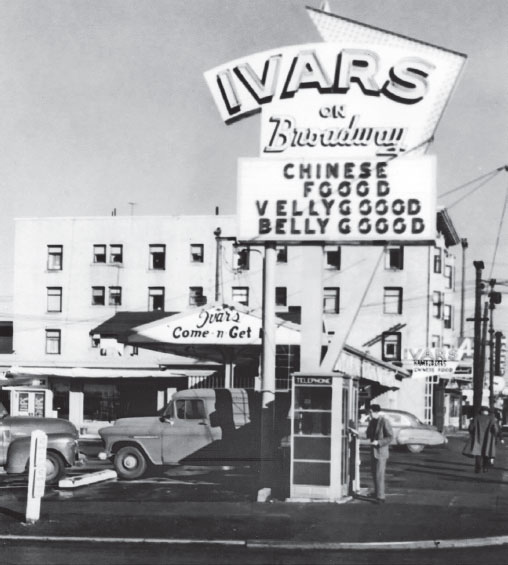
Ivar Haglund’s second fish and chips bar, Ivar’s on Broadway, also served Chinese and Mexican food. Paul Dorpat.
Broome kept the Broadway location going for several years after closing the Wallingford store, but by 1945, it had become Bon’s Café, and Broome had gone on to manage the Dolly Madison Tea Room. Bon’s moved to new quarters in 1950; the old location became Sylvia’s Cafe (under Sylvia Beck). In the 1960s, it was the Luau Barbecue, still operated by Bon; the Luau lasted for about four years before becoming DeCaro’s Barbecue in 1964. Later still it was the Broadway Restaurant.
Paul Wolter had the Nite Owl Cafe at 420 Broadway N in the ’30s. On the other side of the street, Norm’s Cafe, a favorite neighborhood hangout, moved into the Broadway Market in 1928 and moved out fifty years later. There was also a Broadway Lunch in the market for several years, right next door to Norm’s.
In the next block north was the Blue Goose at 516 N Broadway; opened in the 1930s with Donald Hargrove as proprietor, by 1942, it had changed into the Chung Hing Cafe, “Chinatown on Broadway,” specializing in Chinese and American dishes. After thirty years and several different spellings of its name (Chung King, Chun King, among others), it was still there as the Shan Hai, one of the first restaurants in Seattle to feature northern Chinese cooking, in 1975. Later still it was called the Macfong-Ho.
Teddy Thompson had an early lunchroom at 601 Broadway N. In 1940, it was known as Bilyew’s, for proprietor Harlan Bilyew. Bilyew’s didn’t last long; by the next year, Stavig’s Cafe took over. Another early lunchroom was owned by Louis Kulander at 606 Broadway N. This became the site of the Jade Pagoda Cafe, featuring “the fabulous cooking artistry of the Orient and the dining delicacies that are America’s favorites,” with authentic Chinese decorations and a rockery aquarium.
Owned by Jimmy Woo and founded by his uncles in 1943, the Jade Pagoda was long a Broadway favorite for Chinese cuisine, readily distinguished by its Chinese-style tiered tile roof. Jimmy Woo passed away in 1981; his wife, Pearl, and son Bryant continued the family business until closing in 2006. Nearby was a restaurant called the Bit of Sweden, apparently not related to A Little Bit of Sweden on Sixth Avenue downtown. It opened in 1962 with John Hanson as chef and was well known for Swedish pancakes.
RAINIER AVENUE TO COLUMBIA CITY, RAINIER VALLEY AND RAINIER BEACH
Rainier Avenue originates east of downtown off of Jackson Street and follows the west shore of Lake Washington—sometimes close, sometimes nearly a mile away—to Renton, ten miles south. South of Empire Way, where the early Highway 10 followed its own course to Renton, Rainier passes through several neighborhoods—Columbia City, Rainier Valley and Rainier Beach—each with their own business districts. There were restaurants all along the way.
Eve Pronger purchased an old lunchroom at 3107 Rainier and transformed it into Eve’s Hamburger Lunch in 1932. She continued to run it with her husband, Clyde Richardson, for a number of years. In 1959, it was called the Doodle Sack Drive In, possibly a branch of the Doodle Sack on Greenwood. The Richardsons finally cashed out in 1962, selling the place for $70,000 to a developer who wanted to build a mini-mart on the site. A bit farther south, at 3410 Rainier, a hamburger stand called the Square Meal Restaurant was in business as early as 1929.
Kane’s Cafe, at 424 Rainier, was another husband-and-wife operation run by James and Hilda Kane. In 1942, Hilda incurred the wrath of the law for playing the jukebox too loud and was fined fifteen dollars. She didn’t like it; she appealed; and she won. The Kanes were still running the place into the 1960s, when it became a go-go joint. There was still a restaurant at that address in 1981; today, it’s a parking lot.
Until it was annexed to Seattle in 1907, Columbia City was a separate town with a thriving business district, a busy sawmill and electric streetcar connections to the big city. The centerpiece of the town was the Columbia Hotel, a three-story brick structure originally built as a private residence. First called the Hotel Dakota, it was renamed in 1903 and continued in business until 1920. A famous guest was Buffalo Bill Cody. The hotel was well patronized for its Sunday roast beef and chicken dinners—all you could eat for twenty-five cents. Today, the restored building is used for apartments with a restaurant on the ground floor.
The Columbia Cafe, next door to the hotel at 4914 Rainier, started out around 1915 as Mayfield’s. In the 1930s, it was operated by M.B. Watts. The café was recognized in 1979 as being one of the first restaurants in Seattle to introduce Braille menus. The Columbia City Ale House makes its home there today. Across the street were the Little Place Cafe and a couple of early lunchrooms run by Robert Metz and Constantine DeMassi.
There was a café called Our Place half a mile south in the Rainier Valley neighborhood. At 5610 Rainier, a lunchroom was in operation as early as 1919. John and Pearl Cummings ran it in the 1930s before selling it to Charles Jarvis. It later became the Friendly Tavern and was still serving in the ’80s. Another early lunchroom operator, Joseph Celestine, had a place—Joe’s Handy Corner—at 5700 Rainier. By the 1950s, Donald McDorman was running it as the M&M Cafe. Nearby was Ruth’s Coffee Shop, which became a tavern/burger joint after Prohibition was lifted in 1934. The Emerald Isle Cafe was at 5715 Rainier in the ’50s, later becoming the Sun Sun Cafe (in the ’70s) and the Kuriyama Japanese Restaurant in the ’80s.
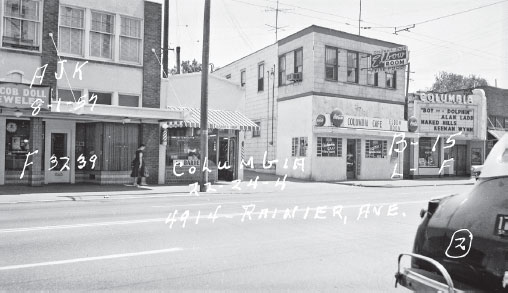
The Columbia Cafe was a longtime fixture in downtown Columbia City. Today, the building is home to the Columbia City Ale House. Washington State Archives Puget Sound Regional Branch.
After its long run south of Seattle, Rainier Avenue finally jogs east to run along the edge of Lake Washington. Here, in the Rainier Beach district, was the Umbrella Grill, open by 1951 with a seating capacity of forty. In the 1980s, a family-run Mexican restaurant, Maya’s, moved in. Maya’s later relocated a few doors away to 9447 Rainier and is still there. The Broil-Lux was a short-lived café at 9428 Rainier. In 1948, the Rainier Beach Cafe opened in a new building at 9445 Rainier. Originally a hamburger and ice cream shop, proprietor Roscoe Knatcal expanded to beer and wine in the ’50s.
AIRPORT WAY AND GEORGETOWN
An argument can be made that Georgetown, not Alki Point, is where Seattle began. Permanent structures were being raised at the Collins homestead there in September 1851 while the Denny party was still shivering in the cold rain at Alki. Georgetown incorporated as a city in 1904—only to be annexed to Seattle six years later. Much of Georgetown’s period architecture still stands along Airport Way, formerly called Duwamish Way.
After Boeing Field, Seattle’s first commercial airport, was constructed in 1928, city leaders realized the need for an efficient route from downtown to the new facility. Rather than building a new highway, as probably would be done these days, the city simply designated a new route overlaid on portions of seven preexisting streets, and Airport Way was born. It immediately became a major thoroughfare, and restaurants began appearing all along its length from where it departed Fourth Avenue S in downtown Seattle all the way to and including the airport.
On Airport Way’s northern end, just south of the important intersection of Highways 99 and 10, was the Gates Coffee Shop, later known as the Airport Cafe. In the 1950s, it was called Al’s Coffee Shop, owned by Irving Bamberg; two decades later, it was Walker’s Cafe.
The Transit Cafe was located in the Atlantic Street Terminal, built in 1942 at Atlantic Street and Airport Way for the city’s transit system. The eatery made no pretensions about its setting: “Atmosphere—don’t come! Good food—do come!” was one of its mottos. The Transit was open for breakfast, lunch and dinner; in 1945, $1.35 would buy a full dinner (choice of nine entrées including top sirloin steak, ham and pork tenderloin), salad, coffee and dessert. A few blocks south was the Sixteen Hundred Cafe, 1600 Airport Way, which only lasted for a few years in the 1950s.
The Blue Bird Cafe opened circa 1934 at 1901 Airport Way; by 1951, it had moved across the street to 1906. Paul Kringle was a longtime manager of the Blue Bird. Just south at 2100 Airport Way, Calvin Coolidge Decker and Sam Volpentest had the Transport Grill inside the Transport Truck Terminal. Open by 1952, it was still in business in 1971. A bit farther along was the Truck Trailer Cafe. This stretch of Airport Way was (and still is) lined with light industrial businesses, and many of the restaurants catered to blue-collar workers—nothing fancy, just places to get a quick meal.
At 2701 Airport Way was the Lander Street Cafe, owned and operated by Kenneth and Maude Hutchins for many years. Renamed Eddie’s Restaurant in 1967, it went out of business a decade later. Erna’s, later Cobb’s Cafe, served up short-order fare for over twenty years at 3003 Airport Way.
Peter Rocha was operating a restaurant at 3923 Airport Way as early as 1937. Originally called the Glendale Cafe, it had become Flynn’s Cafe by the 1950s. Flynn’s was probably the longest-lived of the early Airport Way cafés; it was still going strong in 2007, known for big breakfasts—pancakes and a locally famous specialty, huge sausage, egg and cheese sandwiches—and lunches, where the main attraction was the patty melt. Originally open for dinner (in 1962, a complete Kosher corned beef dinner could be had for $1.25), in its later years, Flynn’s reverted to breakfast and lunch only. The building still stands, home to Romio’s Pizza and Pasta.
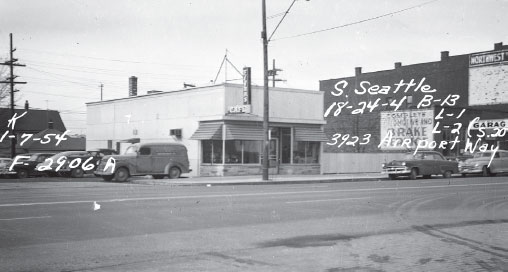
For fifty years, Flynn’s Cafe served up hearty breakfasts and lunches along Airport Way on the way to Georgetown. Washington State Archives Puget Sound Regional Branch.
Across the street from Flynn’s, and a bit more upscale than its neighbors, Adolfo’s Restaurant served Italian food specialties such as veal scaloppini, shrimp pezzaroli, stuffed cannelloni, mastoccioli with Italian sausage, spaghetti and meatballs and ravioli à la pesto. Its predecessor, the Casanova, was run for many years by Esaia Lozzi until his retirement in 1949. Adolfo’s featured Saturday night wine tasting events: sixteen dollars per couple included dinner for two from the dinner menu and “all the wine you can drink in the Gondolier Room.” In later days, Adolfo’s became Goldie’s Airport Way; it is still in business as Bogart’s.
Edward Loeser and Bertha Westow had a combination tavern and café at 4740 Airport Way by 1934. Elmer Bailey purchased the place in 1950 and renamed it Dinty Moore’s. It had disappeared by the 1970s. Just south of this point, Airport Way crosses over a dozen railroad tracks and drops into downtown Georgetown.
A Japanese sushi house now occupies 5503 Airport Way, an address with a long restaurant history. Charles Ogden had an eatery here in 1932; a few years later, it was known as Fay’s, under twenty-year-old proprietor Emma Woods; by the next decade, it was Don’s Cafe, then Frenchie’s Cafe and finally Jim’s Cafe in the 1950s. The Georgetown Sandwich Shop opened around 1932 at 5545 Airport Way
Over the years, many restaurants lined the five blocks of Airport Way as it passed through downtown Georgetown. At 5629 was the C&L Delicatessen & Fountain, owned by Helen Collins and Eva Mae Lewis. Grace Renninger’s Cleveland Cafe (5801), the White Spot Cafe (5821) and the Cafe La France were just down the street, all of them dating back to at least the 1940s. Other early eateries were the Glendale Card & Lunch Room, which by the 1970s was Leo’s Ramble Inn, and the Rainier Restaurant (later the Sunrise Cafe). They didn’t lack for customers—the original Rainier Brewery was just across the street.
Just south of Georgetown on the way to Boeing Field was Al’s DeLuxe Hamburger at 6233 Airport Way. At the airport itself, a lunch counter was in business by 1932. It gave way to the Skyroom in 1940, a plush new dining room opened by Joe Boothby. The Skyroom aimed at attracting more than travelers passing through the airport; its ads invited locals to enjoy dramatic views of airplane activity during a pleasant dinner of choice broiled steaks, seafood or JucyRay Beef. Though the Skyroom survived into the 1970s, passenger traffic declined at Boeing Field after SeaTac airport was constructed, and the restaurant was closed.
FOURTEENTH AVENUE BRIDGE TO SOUTH PARK
For years, South Park was Seattle’s salad bowl. Perched on the bank of the Duwamish River, annual flooding renewed the fertile soils that grew abundant truck crops for delivery to the famous Pike Place Market. The community sits on a main thoroughfare from Seattle to Des Moines and points south, and a small downtown district grew up at the south end of the Fourteenth Street Bridge (now replaced by the new Sixteenth Street Bridge). Several restaurants could be found there before encroaching industrial development drastically changed the character of the neighborhood.
The Nite Cap Cafe, owned by Art Sanders, in business since the early 1940s at 8500 Fourteenth Avenue S, eventually devolved into a typical live music bar. On the same block was Lindgren’s Grill; in early days, Dick’s Ice Creamery occupied the premises. At 8515 Fourteenth Avenue S, the Cheerie Daze Cafe, a contemporary of the Nite Cap, lasted into the 1970s. Farther south on Fourteenth were King’s Burgers at 9133 and Ann’s Snack Shack at 9406 Fourth S. Today, downtown South Park is almost devoid of eateries, though a Mexican restaurant is in Cheerie Daze’s old home.
SPOKANE STREET TO HARBOR ISLAND
Drive south from downtown Seattle on a major arterial such as First or Fourth Avenue. You’ll soon encounter the Spokane Street Viaduct, an elevated roadway that carries huge volumes of traffic between West Seattle and the business district and serves as a main route for long-haul truckers from Harbor Island to the interstates. The imposing structure seems to define the southern edge of the city.
This infrastructure is of recent development, though. Harbor Island, at the mouth of the Duwamish River and at one time the world’s largest artificial island, was created in the early 1900s from material sluiced away by the Denny Regrade project and other efforts to flatten Seattle’s hills. The viaduct was built in 1940 above grade-level Spokane Street. The West Seattle Bridge is 1980s vintage; there wasn’t even a practical vehicle bridge across the Duwamish until 1924.
Portions of Spokane Street survive, though only an echo of pre-viaduct times. In early days, over a dozen restaurants could be found along Spokane Street from its intersection with Fourth Avenue (the route of Highway 99 in pre-freeway days) to its terminus at the base of the West Seattle hill where Avalon Way branches south to climb up to the Junction and Harbor Avenue heads north to wrap around Duwamish Head on its way to Alki Point.
At 228 Spokane Street, the Two Girls’ Restaurant—the two girls being Elsie Adams and Rose Sulz—was in business by 1928; that year, it had the misfortune to be robbed three times in two weeks. Edgar Shadbolt later bought the place, described as an attractive thirty-six-seat lunchroom, just as Prohibition ended. He converted it to a tavern, which at the time probably seemed like a money-making opportunity, but it was gone within a few years.
The Dutchman Cafe, at 101 Spokane, took the reverse route. Initially a tavern, it morphed into a restaurant in 1937, when it began serving home-cooked meals from 6:00 a.m. to 1:00 a.m. As much a roadhouse as a restaurant, the Dutchman featured dancing and floor shows on weekends. Proprietor Charles Moran celebrated the Dutchman’s fifth anniversary in 1939 in gala style with a fifty-cent chicken dinner, a musical performance by the Singing Hawaiian Orchestra and favors for all. Still a lively place into the 1950s, for years, the abandoned building huddled under the viaduct until destroyed by fire in 2009.
Harbor Island and its two waterways (East and West) have been the focus of Seattle’s transoceanic shipping business for over a century. It was natural that eateries appeared to feed the hundreds of industrial workers who flocked in each day. There were the Brass Tavern Lunch at 501 W Spokane Street and the OK Lunch next door at 515, both of them dating from the 1940s, still in business forty years later but now gone.
A bit farther along, Jim Irwin and Louis Laur were operating the Lumber Inn Cafe at 601 W Spokane as early as 1932. The Harbor Island Inn opened at about the same time, with Harry Cotton as proprietor. By 1936, Mrs.Hagny Klones was operating the café; five years later, Jesse Lee Miller took over and continued to run it until his death in 1983.
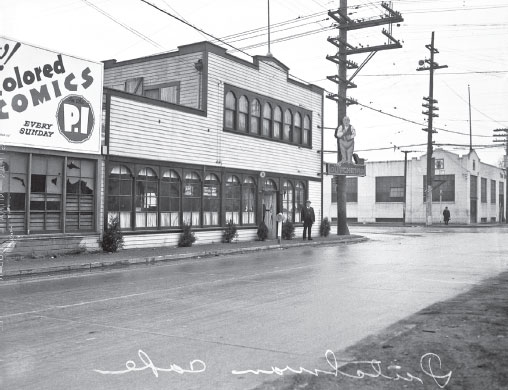
The Dutchman sat at the busy corner of First Avenue S, where traffic headed for West Seattle and the Harbor Island industrial district turned off onto Spokane Street. MOHAI, Seattle Post-Intelligencer Collection, 1986.5.11359.
The Lumber Inn was one of a half dozen lunchrooms scattered among the industrial plants along Spokane Street on Harbor Island. Seattle Municipal Archives, 50109.
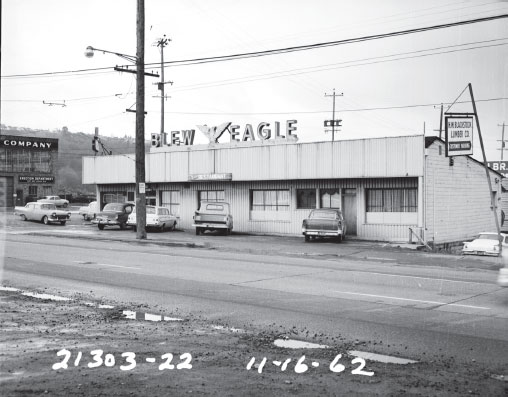
The Blew Eagle was at the western end of Spokane Street, across from the Youngstown steel mill. Seattle Municipal Archives, 74965.
West Seattleites have fond memories of Nifty Hamburger at 1102 Spokane Street. H.E. “Jim” Chambers started his first Nifty on California Avenue up the hill in West Seattle in 1931. A few years later, the Spokane Street location opened, and in 1936, a third shop at Second Avenue and Denny Way followed. Unfortunately, Chambers’s dreams of building a burger empire didn’t work out; the California Avenue shop was sold, and the Denny Way operation failed. The Spokane Street Nifty kept going, though; by 1950, it was known as the Nifty Restaurant and Kayoia Room, owned by Ray Smyser. The restaurant’s site was swallowed up by construction of the new West Seattle Bridge in the 1980s.
After crossing the Duwamish River’s West Waterway, Spokane Street passes through the Youngstown neighborhood. Originally called Humphrey and renamed after the Ohio City when the steel mill was built in 1905, today it is called Delridge. A number of restaurants lined Spokane Street to cater to the steelworkers, including the Tunnel Inn at 2018 Spokane; Andy’s, which opened in the Ship Hotel in 1924 and was still there thirty years later; and the Harbor Inn Cafe, practically next door to Andy’s at 2311 Spokane Street. For many years, Sam Emanuel Nikas managed the Harbor Inn Cafe.
On the north side of Spokane Street was the U & Us Restaurant at 2338, described in 1941 as a fully equipped lunchroom with curb service. The Blew Eagle Cafe was a few doors away at 2370 Spokane Street. When opened by Gino Tognarelli in 1934, it was just one of the many taverns that mushroomed after the repeal of Prohibition, but by the 1940s, the Blew Eagle had transitioned into a restaurant serving full-course dinners, short orders and merchant lunches. Italian food was a specialty. Frank Feeney and Lewis Dickerson purchased the Blew Eagle in the early ’50s, remodeled the place with a large banquet room available for lunches and dinners and offered a complete breakfast, lunch and dinner service plus cocktails. The Blew Eagle is now gone, another victim of West Seattle Bridge construction.
WEST SEATTLE
Alki Point in West Seattle is where it all began, with the arrival of the Denny party in 1851. Today, a monument on Alki Beach commemorates the migrants’ landing and the site of the short-lived town of New York Alki (Alki means “bye and bye” in Chinook jargon, reflecting the hope that the little settlement would eventually grow to rival New York City). Within a few years, practically all the settlers had moved across to the east side of Elliott Bay and Alki Point had reverted to something of a wilderness; even well into the twentieth century, the point was best reached by boat from Seattle.
In 1895, Alfred and Lorena Smith took advantage of Alki Point’s rugged beauty to build the Hotel Alki, advertised as “Seattle’s favorite summer resort,” providing accommodations and serving chicken dinners well worth the long trip from Seattle by boat or horse-drawn vehicle.
The Stockade Hotel replaced the Alki Hotel in 1904. A three-story building with gables and a hipped roof, the Stockade featured massive upright logs supporting the roof and two wraparound porches and gave the building the appearance of a Wild West frontier fort (hence its name). Much of the material used to construct the Stockade came from driftwood cast up on Alki Beach; a fireplace in the lobby was constructed from locally collected stones. A newspaper ad from 1905 highlights the hotel’s attractions: over one hundred rooms, plus additional brand-new cottages; ideal scenery and pure air; boating, surf bathing and clam digging for the outdoorsy type; and unsurpassed cuisine and service with a table d’hôte dinner on Sundays. The ad urged visitors to take the steamer Dix from downtown Seattle to the hotel—only a twenty-minute trip. Unfortunately, the following year, the Dix was involved in a horrific wreck off Alki Point with the loss of over forty lives. The Smiths continued to operate the Stockade well into the 1930s. It was located on what is today the 2900 block of Alki Avenue.
Lonely as it was out on Alki Point in early days, the Stockade Hotel soon had a neighbor—Fir Lodge. William and Gladys Bernard had a home built for them about two blocks east of the Stockade just off Alki Beach, one of the first residences in the vicinity. After several years, the isolation drove them back into downtown Seattle, and Fir Lodge became a clubhouse and weekend retreat for the Seattle Auto and Driving Club. Swend Neilson and Fred Fredricksen purchased Fir Lodge in 1950 and converted it to a restaurant called the Alki Homestead. It was resold five years later to Walter and Adele Foote and sold again in 1962 to Doris Nelson.
It was Nelson who created the restaurant’s “bit of old Seattle” theme. Basically a big log cabin with a huge stone fireplace against the main wall, an old-fashioned dining room of tables set with white lace cloths, cut glass and old-fashioned lamps and decorated with antiques, the Alki Homestead’s main attraction was simple down-home cooking served family style. A 1975 restaurant review well described the place:
Alki Point was still a windswept, lonely place when the Stockade Hotel opened in 1904. University of Washington Special Collections, CUR341.
The Homestead’s food, like Grandmother’s, is simple. It is basically chicken (pan-fried), steak (grilled) and seafood (deep-fried). Ham and prime rib are also available.…The house specialty is country-fried chicken; the crust is crisp and flavorful; the meat was tender and moist. It was perfectly greaseless.…Chicken dinners come in two prices. For $4.65 you get four pieces of chicken, soup, salad, mashed potatoes and gravy (or, optionally, a baked potato with a light cheese sauce), vegetables and biscuits. For $5.15 you get the same goodies, but you can have second helpings.
Side dishes were simply prepared: broccoli was just that—broccoli; salads were mostly lettuce, nothing fancy. The baking powder biscuits were served just warm enough to melt the butter.
Doris Nelson passed away in 2004, but her restaurant fell into good hands and remained immensely popular—until 2009, when fire seriously damaged the old building. Almost immediately after the flames were put out, a movement was underway to preserve the old building. As of this writing, it is being reconstructed, and hope remains high in West Seattle that the Alki Homestead will soon reopen.
West Seattle sits atop a ridge extending from Duwamish Head on Elliott Bay to the city limits five miles south. A mile wide and at an elevation averaging about 350 feet, it is Seattle’s largest neighborhood. California Avenue runs due north–south along the spine of the ridge and contains three distinct business districts—Admiral, Alaska and Fauntleroy—all of them at important arterial road intersections.
The original town of West Seattle, in the present-day Admiral district, was platted in 1885 when the only practical transportation to Seattle was via steamship across Elliott Bay. Railroad connections were established soon after the turn of the century, and by 1906, a bridge—shared by streetcars, pedestrians, horse-drawn vehicles and early autos—made connections easier. The year 1907 saw a new streetcar route established; crossing the Duwamish, it climbed up Avalon Way and Alaska Street to a junction with an earlier streetcar line running along California Avenue. Though there was hardly any development in the area at the time, within a few years, the Junction, as it came to be called, had developed into a full-blown commercial district. Yet another streetcar junction developed at the intersection of California Avenue and Fauntleroy Way, and it, too, soon attracted businesses.
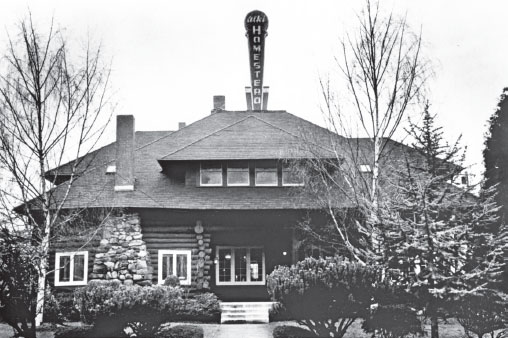
The beloved Alki Homestead, a West Seattle favorite for sixty years, currently awaits restoration after a devastating 2009 fire. Author’s collection.
In the Admiral district, the northernmost of the three, was the Bliss Cafe. Located at 2342 California Avenue and in business by 1920, it was one of the earliest cafés in the district. Emerson Bliss advertised his place as “the outstanding cafe in West Seattle,” and located as it was across from the Portola Theatre, it did an active trade with moviegoers. In 1930, the café ushered in a new line of soda and sundaes—“Absolutely new…you’ve never tasted anything like them”—with a naming contest to be held. By the end of the decade, the Jig Saw Tavern occupied the premises; today, it’s an Indian restaurant.
Just north was the West Seattle Coffee Shop, owned by Evelyn Schiermeyer. In 1935, it was witness to a tragedy. A jilted suitor saw his ex-girlfriend through the window of the coffee shop; he attempted to enter but was quickly ejected for being intoxicated and the door locked against him. Breaking in through a rear door, he took a shot at the young woman but missed; he then turned the gun on himself and took his own life. A few years later, Martha Sanger took over the restaurant, serving special Saturday chicken dinners that were so popular they often ran out of food. It had become Nell’s Coffee Shop by 1951, becoming Brown’s and then Bolton’s Coffee Shop a few years later. In 1963 and with yet another name—Bailey’s Cafe—it was a popular place for Sunday and holiday smorgasbord.
The mother-and-daughter team of Pearl MacLean and Aris Manes ran the Admiral Fountain & Lunch, opened in May 1942 in the new Admiral Theatre building. It was a small place with a counter, five red swivel-top stools and only one table and served breakfast, lunch and dinner. A Friday tradition was a Thanksgiving-style turkey dinner with turkey, dressing, cranberry sauce and pumpkin pie. Customers remember no one ever leaving hungry—if they had no money, they were assigned chores like washing dishes or hauling garbage.
At the end of the block was Skipper’s Galley, a place many Seattleites recall as a surreal dining experience. Immediately after being seated, and before menus or water were presented, plates of food—sliced vegetables, baked beans, meatballs, salads, mixed nuts and many others—started appearing on the table. By the time the menu arrived, most diners were already so stuffed from the appetizers (if that’s the correct way to describe them) that choosing an entrée was something of a challenge not made easier by the menu being a two-inch-thick three-ring binder. It took time to work through the menu; meanwhile, the plates of food kept arriving, and all the while, the staff (apparently the owner-chef ’s entire family) stood by watching in silence. A stack of Styrofoam carry-out containers ready at hand was evidence that few customers finished their dinners; what wasn’t eaten was packed up by the helpful staff and ready to go—probably enough leftovers for several days’ worth of meals at home.
On Admiral Way just east of California were the Happy Hour Cafe and the Admiral Benbow Inn. Bert and Bill McGonagle opened the Happy Hour in 1950; initially just a snack bar inside a tavern, within two years and under new management, it had upgraded itself to a full-service café serving breakfast, lunch and dinner. Mr. and Mrs. Earl Ridgwell had charge of the place.
Kelly’s Admiral Way Cafe was next door at 4212 Admiral Way. Owner Sima Kelly dished up “appetizing meals served in pleasant surroundings…a nice choice of entrees, well cooked and properly served.” In 1939, the Sunday turkey dinner cost sixty cents; merchant lunches ranged between twenty-five and thirty-five cents on weekdays. For a short time, Kelly’s became Gardner’s Cafe & Lounge; purchased by Lloyd and Neisa Longmire in 1950, it was remodeled, redecorated and renamed the Admiral Benbow Inn. It was still in business in 2000.
Back on California Avenue heading south, Charles MacBeth was running Red’s Cafe as early as 1934. Red’s was open for lunch and dinner with drive-in parking and fountain service. Hamburgers were on the menu along with Spanish or chicken tamales, chili and hot and cold sandwiches. By 1961, Red’s had become Eng’s Cafe; a few years later, it was the Chalet Buffet, an all-you-can-eat place where breakfast, lunch and dinner each cost about $1.50. The building, at 2605 California, still houses a restaurant these days.
On the east side of California was the Avenue Fish & Chips Shop. Owner Floyd Cady also served Mexican chili. A few doors down, at 2648 California, the Dipper Shop featured its own made-on-the-premises ice cream. The shop received a makeover in 1939, and a lunch counter—the Dipper Grill—was added with sandwiches, dinners and complete fountain service; chicken potpies were a specialty. Practically next door was Nowlin’s Lunch. In 1929, Mr. and Mrs. Jerry Nowlin purchased the original Vann Bros. location at 2656 California and renamed it Nowlin’s Lunch Counter with lunch, ice cream and candies. Yet another ice cream place, the Lucas Dairy Store, sat right next to Nowlin’s at 2660 California.
Several restaurants were scattered along the mile-and-a-half stretch of California Avenue between Admiral Way and Alaska Street. The Seattle city directory lists two restaurants with intriguing names in the 2700 block of California—the Tillicum Teepee and the Indian Inn—but little is known about them. In 1932, Ralph Colbert had a hamburger stand at 2761 California, the address of the Tillicum Teepee; whatever was there was gone by 1954. A 1950 newspaper ad for the Indian Inn (open for dinner only) named Kate and Jim Johnson as the owners. The Freezer, another ice creamery turned lunch counter, was next door to the Indian Inn at 2775 California. In addition to its own ice cream, the Freezer served hamburgers, twelve-inch hot dogs, chili and short-order breakfasts.
Wing Chin owned the Hi Hat Cafe at 3221 California. Its grand opening was in December 1949, with Chinese and American food “served to your taste.” Thirty years later, the building had become a real estate office. Nearby was the Icicle Fountain & Lunch, with five booths, ten stools and a fully equipped fountain service. Charles and Emma Lewis started the Icicle in 1949, selling it four years later to a Canadian couple, Kenneth and Beatrice Ritchie.
At 3726 California was Kelly’s Drive-In; when it opened in 1952, Kelly’s billed itself as “Seattle’s newest self service drive-in.” An order of Kelly’s special chicken and fries cost eighty-three cents; also on the menu were hamburgers (regularly nineteen cents but only fifteen cents with coupon), fish and chips, shrimp and malts. Kelly’s was open 11:00 a.m. until 2:00 a.m.
The Junction—the busy intersection of California Avenue and Alaska Street—was a magnet for businesses of all types, with plenty of restaurants mixed in. A block north of the intersection, at 4454 California, was Helen’s Fine Foods, serving lunch and dinner, with pancakes a specialty. In 1939, Alice’s Grill was just a few feet away on the corner of California and Oregon Streets. Alice Ford prepared all sandwiches and meals in a spotlessly clean kitchen; said a contemporary newspaper review, “The noonday lunches and evening meals served at Alice’s Grill have won for them an enviable reputation in this community.” Alice’s was known for steak dinners but apparently was only in business for a few years in the early 1940s.
Gust N. Pothakos was the owner of Gust’s Cafe. There is some uncertainty about its location; Gust may have started in the spot left vacant by Alice’s Grill, but by the ’50s, he was firmly in place at 4533 California. The restaurant disappeared within a decade. Directly across the street from Gust’s was Snyder’s Cafe, open as early as 1931 under George Snyder. There’s a jewelry store there now.
A longtime West Seattle institution at 4542 California Avenue, Vann Bros. Restaurant actually had its origins up in the Admiral district in the early 1920s. By 1934, brothers Ervin and Rueul Vann had relocated to the Junction, where they stayed for nearly fifty years. Vann Bros. was similar to the Ben Paris shops in downtown Seattle—part sporting goods store, part ticket outlet for sporting events, part café. Over time, the restaurant part of the business took over, with a dining room as well as booth and counter service. Vann’s built its reputation on complete dinners with a variety of entrées, particularly seafood and charbroiled steaks—at moderate prices. After Rueul Vann passed away in 1966, Ervin continued to run the place before closing in 1984. Relatively unchanged, today the building is home to an Indian restaurant.
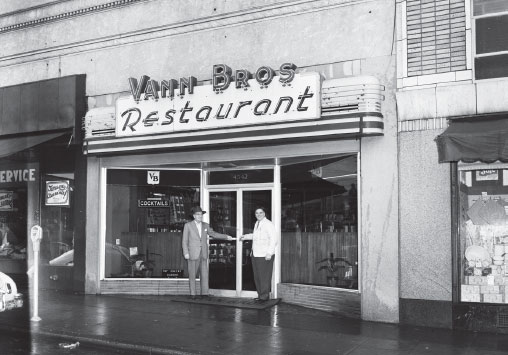
The Vann brothers—Ervin and Rueul—wait to greet guests to their restaurant in this 1952 photo. Seattle Municipal Archives, 23351.
Sandy’s Cafe, on Alaska Street just off California, started out as Mac’s Hamburger and Waffle Stand. In 1926, Harry “Mac” McCleary moved around the corner to 4710 California, and his old location became Tom’s Lunch, owned by Tom Aleck. Tom’s was later operated by Hazel Small, and by 1951, it had become Sandy’s Cafe, run by Robert and Jessie McLaughlin. The new Mac’s continued well into the 1940s, open for breakfast, lunch and dinner and specializing in steaks and chops. The late ’40s saw several changes of ownership at Mac’s; for awhile, it was the Phelps Cafe, owned by Mr. and Mrs. M.M. Phelps. Sold by the Phelpses in 1950 to Katherine Hayes, it received a new name—the West Seattle Cafe—but was gone within a few years.
The New Luck Toy, a Chinese restaurant at 4718 California, may have had an earlier existence on Spokane Street in the industrial district. By 1950, it was well established at the Junction and remained there for over thirty years. Alan Louie was the owner. Across the street, at 4725 California, was a place that went through a number of name and cuisine changes over the years: opened in 1929 as the Chocolate Shop, by the 1930s, it was one of the outlets for the Manning’s Coffee chain. Sometime in the 1960s it became known as the Coffeeland Cafeteria.
The 1970s saw it reborn as the Phoenicia, owned by Hussein Khazaal and featuring Lebanese food and specialties from the Balkans, North Africa and the Mediterranean. The menu listed sixteen different dinners—three choices of seafood, three curries, many vegetarian plates—and particular favorites such as shish kabobs and couscous (lamb shanks simmered in a sauce of peppery vegetables served over rice mixed with raisins). The Phoenicia later moved to Alki Avenue, and the Meenar Pakistani Restaurant took its place; lamb dishes were its specialty. It is now a Japanese restaurant.
The Siberrian, a 1940s-era lunch place open for lunch and dinner at 4728 California, offered up fish and chips, steaks, hamburgers and hot dogs. An order of deep-fried shrimp, chips, salad and toast was thirty cents. Down the block was another Chinese restaurant, the Fong Fong, in business during the 1960s. John’s Drive In Barbecue & Freeze occupied the odd-shaped corner at 4803 California Avenue; one hundred yards farther on was the Wagon Wheel Cafe.
Nifty Hamburger, later relocated to Spokane Street, opened its first shop at 4829 California in 1931. R.M. Morse purchased it in 1934 and kept a hamburger stand going there. By 1939, it was a place called the Spot, run by a Mrs. Sellars, known for her clam chowder, cube steak dinners and pies.
The D-G Coffee House, opened in 1942 at 4847 California, offered fried chicken for $0.70, baked ham for $0.65 and potted beef with brown gravy for $0.50—each served with mashed potatoes, two fresh vegetables and buttered toast. By 1950, it had become Anita’s Steak House, owned by Dave and Anita Neimi. Four years later, Anita’s gave way to Kermit’s Charcoal Broiler, with prime rib, steaks, butter-fried chicken and seafood on the menu. The Spencer House later took over; in 1969, its special New York steak, “broiled to your taste,” with green salad, choice of dressing, baked potato with butter or cheese, a roll and butter was priced at $2.95. The Spencer House became Phase II; Phase II turned into the Yung Ya, a Chinese American restaurant with “the most relaxing atmosphere, best Chinese & American food at reasonable prices in West Seattle.” There’s a modern apartment building there today.
Several restaurants sat alongside the main arterial that climbed up West Seattle hill from the end of Spokane Street. Gil’s Hamburgers, at Thirty-Fifth Southwest and Avalon Way, was the third and final location of the local burger chain that originated along Rainier Avenue. The interestingly named Laff-Alot Cafe, at 4435 Fauntleroy Avenue with Leilia Scrimsher as proprietor in the ’50s, featured chicken in a basket. Saturday, when the Laff-Alot stayed open until 1:00 a.m., was french-fried prawns night.
Mr. B’s Double Decker Hamburgers, California Mission–styled with tiled roof and stucco exterior, was tucked into the corner of Fauntleroy Way and Thirty-Eighth Street. Inside was the perfect example of a 1950s diner: a curved counter with milkshake machines and a Coca-Cola dispenser; six booths and ten stools; a gleaming backbar with pies, cakes and chilled milkshake glasses; and a jukebox. In addition to the trademark double-decker hamburgers ($0.45 in 1954), Mr. B’s served steak dinners (three different varieties, priced from $1.25 to $1.75 and accompanied by fries, a salad and toast) and milkshakes and malts. Ham and eggs were available at any time for $0.85. The building still exists, in use as a dry cleaners.
Back on California Avenue, Chuck and Terry’s Fish & Chips was about three-quarters of a mile south from the Junction. Chuck and Terry Mills opened their shop in the early 1950s and served hamburgers and sandwiches in addition to their mainstay items. The building was enlarged, completely remodeled and renamed Terry’s Restaurant in 1962 with full lunch and dinner service. A dining room was added to supplement the original counter and stools; an Oriental garden with a bubbling fountain served for outdoor dining. Terry’s featured steak dinners and seafood dinners, but fish and chips were still on the menu. By 1977, the Cretan Bull, a Greek restaurant, had taken Terry’s place, and a few years later, one of the local chain of Guadalajara restaurants moved in.
Gino’s was an early Italian restaurant along California, opened in 1962 and guaranteeing “real Italian atmosphere.” A dinner-only place, Gino’s menu listed customary Italian favorites such as pizza and spaghetti along with chicken dishes. Nearby was a short-lived place called Nate & Kate’s Restaurant. Across the street from Gino’s, the Snappy Lunch Room held sway as early as 1932; in later years, it became Chuck & Sally’s Tavern.
The counter gleams, the stools are ready, the specials are posted above the back bar and a smiling waitress is ready to take orders at Mr. B’s in 1954. Seattle Municipal Archives, 78963.
Several restaurants collected at the California-Fauntleroy intersection. The D&E Cafe, on the northwest corner, served breakfast, lunch and dinner. It later dropped food service and was remade as the White Horse Tavern. In 1941, Lyle and Thelma McAlmond, previous owners of the Gatewood Lunch a few blocks away, opened the Morgan Street Lunch. They advertised the best hamburger in town for ten cents. Sold and resold several times, by 1954, the thirty-seat restaurant had become the Circle Cafe. At 6505 California, the C-Q Coffee Shop, owned by Harry Turban, served breakfast, lunch and dinner with emphasis on fish and chips, hamburgers, sandwiches and daily specials called “big plate meals.”
Back at water level along Elliott Bay, Alki Beach was well on its way to being developed as Seattle’s playground soon after 1900. Roads began to follow the water’s edge toward the formerly isolated point; streetcar lines were planned, and beach cabins started to appear. In 1907, Luna Park rose at Duwamish Head, the largest amusement park Seattle ever had; brilliantly illuminated, each building, ride and attraction outlined in lights, its glitter lit up the night sky across the water from downtown Seattle.
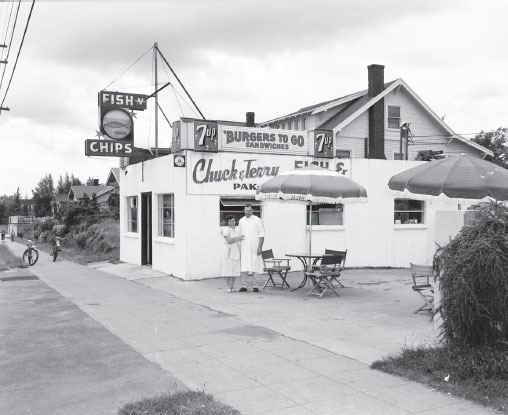
Two people—presumably owners Chuck and Terry Mills—pose outside Chuck and Terry’s Fish & Chips in 1953. Seattle Municipal Archives, 24462.
It’s likely that the café and other concessions at Luna Park were the first food-service places along Alki, apart from the Stockade Hotel at the west end of the beach. As time passed, the café transformed into a liquor emporium—the best-stocked bar in Seattle. Local outcry arose about the ready availability of liquor to minors and the general dissipation of parkgoers; in fact, the effort to get rid of the park was partly behind West Seattle’s annexation to the larger city. When the park closed in 1913 and the rides and salvageable building were dispersed to other amusement parks, West Seattle probably breathed a sigh of relief.
At 1317 Harbor Avenue, just north of where California Avenue drops off the hill back to sea level, was the West Side Inn. In the late ’30s, when Chad Ballard was manager, the inn’s food offerings were limited to a “Chinese food department” with chop suey, chow mein and other Chinese dishes available for takeout. In 1939, a dining room was added, specializing in something called “diplomatic hamburgers,” homemade pies and hillbilly music; southern fried chicken, banquet style, was available by request. In the ’60s, a well-known jazz club, the Embers, occupied the building.
By and large, eateries seemed slow to develop along Alki Beach. Jane Ferran had a lunch counter at 2762 Alki in 1932; that same year, Emil Schanno started up a café later known as Sherwood’s, serving lunches, dinners, sandwiches, short orders and a special seven-course dinner each Sunday (choice of turkey, chicken, rabbit or steak). By 1939, it had become Crook’s Dining Room, operated by Charlotte Crook; still later, it was called the Alki Cafe, under management of Isabel Mitchell.
A place called Eat With Casey opened at 2716 Alki in the ’50s; ten years later, it had been taken over by Irene Scovil and was known as Irene’s Steak House. The Phoenicia, relocated from the Junction in the 1970s, is now the address’s longtime tenant. On the next block east on Alki was Nick’s Cafe at 2700, now the site of an apartment building. Today the epicenter of restaurants along Alki is the area just east of the Birthplace of Seattle monument at Sixty-Third and Alki Avenue—where it all began.